专业英语第七单元
高分子材料与工程专业英语
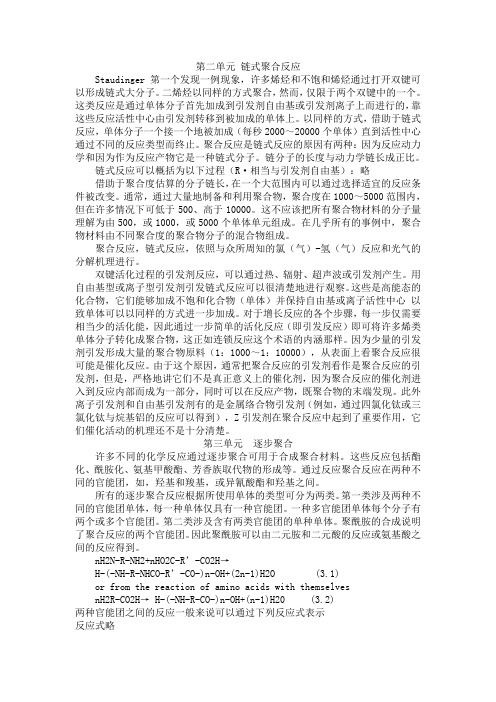
第二单元链式聚合反应Staudinger第一个发现一例现象,许多烯烃和不饱和烯烃通过打开双键可以形成链式大分子。
二烯烃以同样的方式聚合,然而,仅限于两个双键中的一个。
这类反应是通过单体分子首先加成到引发剂自由基或引发剂离子上而进行的,靠这些反应活性中心由引发剂转移到被加成的单体上。
以同样的方式,借助于链式反应,单体分子一个接一个地被加成(每秒2000~20000个单体)直到活性中心通过不同的反应类型而终止。
聚合反应是链式反应的原因有两种:因为反应动力学和因为作为反应产物它是一种链式分子。
链分子的长度与动力学链长成正比。
链式反应可以概括为以下过程(R·相当与引发剂自由基):略借助于聚合度估算的分子链长,在一个大范围内可以通过选择适宜的反应条件被改变。
通常,通过大量地制备和利用聚合物,聚合度在1000~5000范围内,但在许多情况下可低于500、高于10000。
这不应该把所有聚合物材料的分子量理解为由500,或1000,或5000个单体单元组成。
在几乎所有的事例中,聚合物材料由不同聚合度的聚合物分子的混合物组成。
聚合反应,链式反应,依照与众所周知的氯(气)-氢(气)反应和光气的分解机理进行。
双键活化过程的引发剂反应,可以通过热、辐射、超声波或引发剂产生。
用自由基型或离子型引发剂引发链式反应可以很清楚地进行观察。
这些是高能态的化合物,它们能够加成不饱和化合物(单体)并保持自由基或离子活性中心以致单体可以以同样的方式进一步加成。
对于增长反应的各个步骤,每一步仅需要相当少的活化能,因此通过一步简单的活化反应(即引发反应)即可将许多烯类单体分子转化成聚合物,这正如连锁反应这个术语的内涵那样。
因为少量的引发剂引发形成大量的聚合物原料(1:1000~1:10000),从表面上看聚合反应很可能是催化反应。
由于这个原因,通常把聚合反应的引发剂看作是聚合反应的引发剂,但是,严格地讲它们不是真正意义上的催化剂,因为聚合反应的催化剂进入到反应内部而成为一部分,同时可以在反应产物,既聚合物的末端发现。
新闻传播学专业英语教程第二版第七单元课后答案
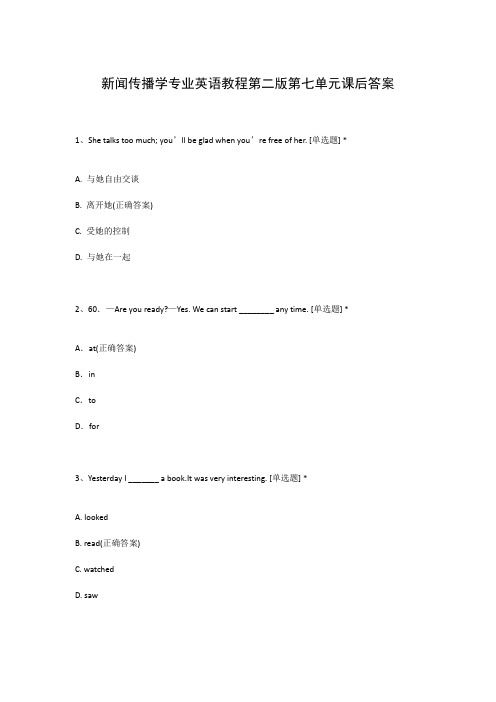
新闻传播学专业英语教程第二版第七单元课后答案1、She talks too much; you’ll be glad when you’re free of her. [单选题] *A. 与她自由交谈B. 离开她(正确答案)C. 受她的控制D. 与她在一起2、60.—Are you ready?—Yes. We can start ________ any time. [单选题] *A.at(正确答案)B.inC.toD.for3、Yesterday I _______ a book.It was very interesting. [单选题] *A. lookedB. read(正确答案)C. watchedD. saw4、The black coal there shows a sharp()white snow. [单选题] *A. contract withB. content withC. contact toD. contrast to(正确答案)5、With all the work on hand, he _____ to the cinema last night. [单选题] *A.should goB.must have goneC.might goD..shouldn’t have gone(正确答案)6、Don’t _______ to close the door when you leave the classroom. [单选题] *A. missB. loseC. forget(正确答案)D. remember7、Sorry, I can't accept your invitation. [单选题] *A. 礼物B. 观点C. 邀请(正确答案)D. 好意8、—______ do you play basketball?—Twice a week.()[单选题] *A. How often(正确答案)B. How muchC. How manyD. How long9、What’s the point of going to school when I can’t do anything there? [单选题] *A. 时间B. 意义(正确答案)C. 方向D. 目标10、_____ to wait for hours,she brought along a book to read. [单选题] *A. ExpectedB. Expecting(正确答案)C. ExpectsD. To expect11、—These shoes look cool. ______ are they?—They are on sale, only $()[单选题] *A. How much(正确答案)B. How longC. How manyD. How soon12、On Easter children _______ eggs around the house. [单选题] *A. hunt for(正确答案)B. send forC. prepare forD. ask for13、I like this house with a beautiful garden in front, but I don't have enough money to buy _____. [单选题] *A. it(正确答案)B. oneC. thisD. that14、I used to take ____ long way to take the bus that went by ____ tunnel under the water. [单选A. a, aB. a. theC. a, /(正确答案)D. the, a15、86.—? ? ? ? ? ? ?will it take me to get to the Golden Street?—About half an hour. [单选题]* A.How farB.How long(正确答案)C.How oftenD.How much16、72.—? ? ? ? ? ? ? ? ? ? ? ??—Yes, please. I want a sweater. [单选题] *A.How muchB.Can I help you(正确答案)C.Excuse meD.What will you take17、He _______ walks to school, because he lives near school. [单选题] *A. sometimes(正确答案)C. doesn’tD. don’t18、I think _______ is nothing wrong with my car. [单选题] *A. thatB. hereC. there(正确答案)D. where19、--Do you often go to the cinema _______ Sunday?--No, we _______. [单选题] *A. on; don’t(正确答案)B. on; aren’tC. in; doD. in; don’t20、—Can you play the violin at the art festival?—No, I ______. But I am good at playing the drums.()[单选题] *A. canB. can’t(正确答案)C. do21、_____ whether robots will one day have vision as good as human vision. [单选题] *A. What is not yet knownB. It is not yet known(正确答案)C. As is not yet knownD. This is not yet known22、Some people were born with a good sense of direction. [单选题] *A. 听觉B. 方向感(正确答案)C. 辨别力D. 抽象思维23、42.—________ meat do you want?—Half a kilo. [单选题] *A.How much(正确答案)B.How manyC.WhatD.Which24、There is _______ meat in the fridge.Lets go and buy some. [单选题] *A. little(正确答案)B. a littleC. fewD. a few25、Grandfather lives with us. We all _______ him when he gets ill. [单选题] *A. look after(正确答案)B. look atC. look forD. look like26、—Is this Tony’s history book?—No, it isn’t ______.()[单选题] *A. himB. his(正确答案)C. heD. himself27、—______? —Half a kilo.()[单选题] *A. How much are theyB. How much is itC. How much would you like(正确答案)D. How many would you like28、_______ your parents at home last week? [单选题] *A. IsB. WasC. AreD. Were(正确答案)29、Across the river(). [单选题] *A. lies a new built bridgeB.lies a newly built bridge(正确答案)C. a new built bridge liesD.a newly built bridge lies30、_______ your help, I passed the English exam. [单选题] *A. ThanksB. Thanks to(正确答案)C. Thank youD. Thank to。
计算机专业英语单词
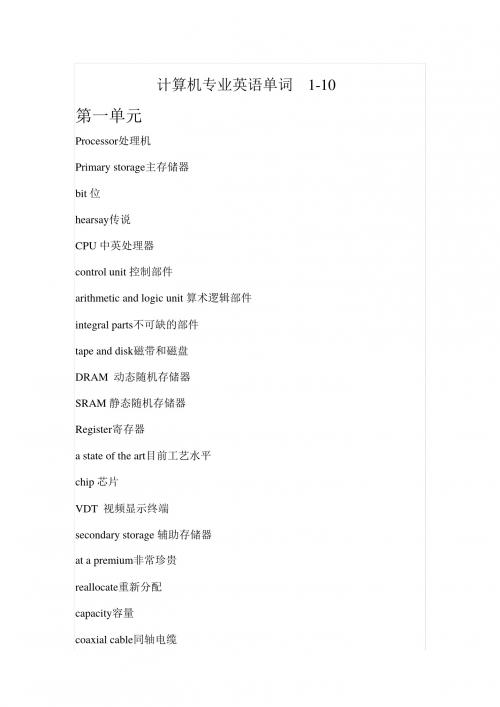
snippet小片,断片 statement声明 menu菜单 site 站点 guru宗教老师 CSS叠层样式 heterogeneous异质的 paramount至上的 delivery 递送,交付 platform 平台 project 计划 embedded嵌入式系统 portable可移植的 distributed 分布式 real-time 实时的 end-user终端用户 desktop桌面 requirement需求 deploy 开展 performance性能 survive 幸存 adaptable能适应的
第十单元
abstraction抽象 domain定义域 idealized理想化 inventory 库存 stock level库存水平 reorder在订购 toss掷 dice 股子 initializer 初始化 algorithm 算法 stack栈
syntax recognition语法识别 expression evaluation表达式求值 function call 函数调用 a pile of boxes一叠盒子 push压入 pop弹出 lifo 后进先出 rack 架 linked list 链表 declaration说明 index 索引 Turing machine 图灵机 Computability 可计算 Equivalent 相等的 Geometric几何的
program and data程序和数据 instruction 指令 location 单元 RAM 随机存取存储器 Hardwired 硬连线 EPROM 可擦可编程只读存储器 Cache高速缓存 Throughput 吞吐量 read-mostly以读为主 EEPROM 电可擦编程 ROM Nonvolatility 非易失性 Updatable可修改的 in place在适当的地方 semiconductor半导体 flash memory闪存 functionality 功能 byte-level 字节级 be referred to as称作 virtually 事实上 house存放 expansion扩充 peripheral外围的
综合英语教程(第三版)BOOK2-课文译文 07.第七单元
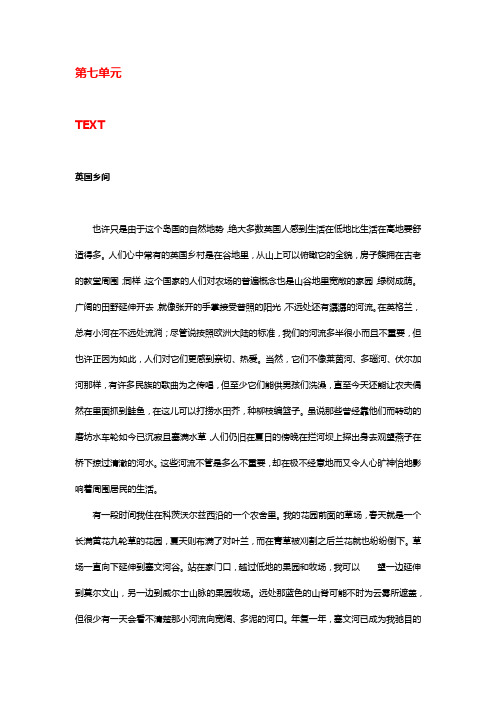
第七单元TEXT英国乡间也许只是由于这个岛国的自然地势,绝大多数英国人感到生活在低地比生活在高地要舒适得多。
人们心中常有的英国乡村是在谷地里,从山上可以俯瞰它的全貌,房子簇拥在古老的教堂周围;同样,这个国家的人们对农场的普遍概念也是山谷地里宽敞的家园,绿树成荫。
广阔的田野延伸开去,就像张开的手掌接受普照的阳光,不远处还有潺潺的河流。
在英格兰,总有小河在不远处流淌;尽管说按照欧洲大陆的标准,我们的河流多半很小而且不重要,但也许正因为如此,人们对它们更感到亲切、热爱。
当然,它们不像莱茵河、多瑙河、伏尔加河那样,有许多民族的歌曲为之传唱,但至少它们能供男孩们洗澡,直至今天还能让农夫偶然在里面抓到鲑鱼,在这儿可以打捞水田芥,种柳枝编篮子。
虽说那些曾经靠他们而转动的磨坊水车轮如今已沉寂且塞满水草,人们仍旧在夏日的傍晚在拦河坝上探出身去观望燕子在桥下掠过清澈的河水。
这些河流不管是多么不重要,却在极不经意地而又令人心旷神怡地影响着周围居民的生活。
有一段时间我住在科茨沃尔兹西沿的一个农舍里。
我的花园前面的草场,春天就是一个长满黄花九轮草的花园,夏天则布满了对叶兰,而在青草被刈割之后兰花就也纷纷倒下。
草场一直向下延伸到塞文河谷。
站在家门口,越过低地的果园和牧场,我可以望一边延伸到莫尔文山,另一边到威尔士山脉的果园牧场。
远处那蓝色的山脊可能不时为云雾所遮盖,但很少有一天会看不清楚那小河流向宽阔、多泥的河口。
年复一年,塞文河已成为我驰目的景色的一部分,它甚至已成为我意识的一部分。
(吕睿中译, 胡一宁审校)READ MORE乡村生活人们会激动地说:“哦,你真有福气,住在巴斯,它是个美丽而又可爱的历史之地。
”然而你所能想起来的只有那糟糕的停车场,拥挤的旅游人,昂贵的商店,狭隘偏执的市议会,还有那糟糕的交通…幸运的是我并不住在巴斯,而是住在差不多10英里开外的埃文河谷里一个名叫林普利·斯托克的小村。
如今,在城里工作的专业人员宁愿选择住在乡村,人们认为这种现象很平常了。
九年级全一册英语第七单元笔记
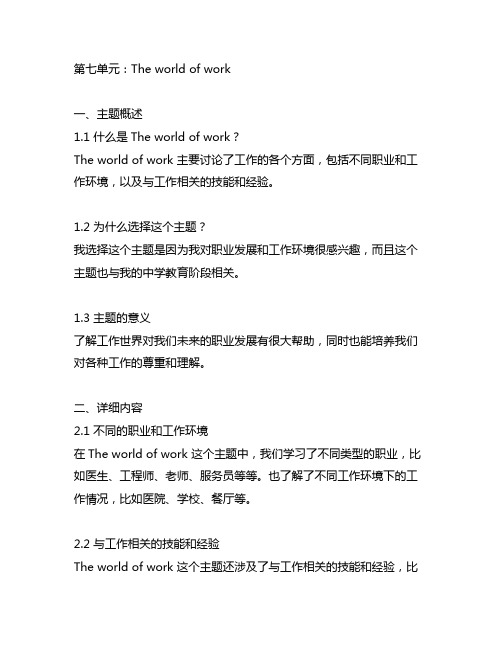
第七单元:The world of work一、主题概述1.1 什么是The world of work?The world of work 主要讨论了工作的各个方面,包括不同职业和工作环境,以及与工作相关的技能和经验。
1.2 为什么选择这个主题?我选择这个主题是因为我对职业发展和工作环境很感兴趣,而且这个主题也与我的中学教育阶段相关。
1.3 主题的意义了解工作世界对我们未来的职业发展有很大帮助,同时也能培养我们对各种工作的尊重和理解。
二、详细内容2.1 不同的职业和工作环境在The world of work 这个主题中,我们学习了不同类型的职业,比如医生、工程师、老师、服务员等等。
也了解了不同工作环境下的工作情况,比如医院、学校、餐厅等。
2.2 与工作相关的技能和经验The world of work 这个主题还涉及了与工作相关的技能和经验,比如沟通能力、团队合作、解决问题能力等。
这些技能和经验对于我们未来的职业发展至关重要。
2.3 个人观点和理解就我个人而言,我认为了解The world of work 这个主题能够帮助我更清晰地认识到不同职业的重要性,以及不同工作环境下的工作方式。
在学习过程中,我也意识到了一些我需要提升的技能和经验,比如更好地处理工作中的压力,提高沟通能力等。
三、总结和回顾通过学习The world of work 这个主题,我对工作世界有了更深入的了解,也更清楚地认识到了自己的职业发展方向和需要提升的技能。
这个主题不仅帮助我认识到了工作的重要性,同时也激发了我对未来职业的向往和努力的方向。
以上就是我根据你提供的内容和主题撰写的有关九年级全一册英语第七单元的文章,希望对你有所帮助。
对于学生来说,学习The worldof work 这个主题不仅可以帮助他们了解工作世界,还可以培养他们未来的职业意识和规划能力。
通过探索不同职业和工作环境,学生可以更清晰地认识到自己的兴趣和优势,从而为未来的职业选择做好准备。
习题册答案-《汽车专业英语(第二版)习题册》-B24-1592
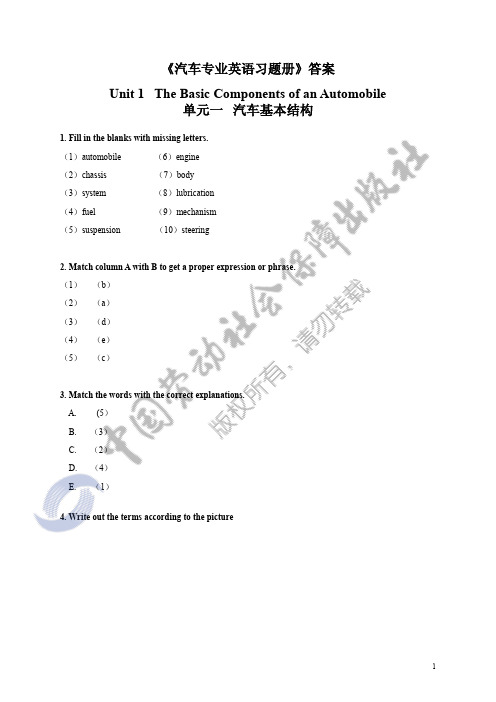
8. Rearrange the following sentences to get a reasonable paragraph with your dictionary.
CBDA
Unit 2 Instrument Panel
2
单元二 仪表板
1. Fill in the blanks with missing letters.
4
(9)ignition key
(10)anti-lock bark
7. Translate the following sentences into Chinese.
(1)若指针超过正常区域,发动机会因过热而受损。 (2)或许我可以找到除本田之外喜爱的车。 (3)银行可以为你提供低息贷款。 (4)这两家公司都生产卡车和客车。
5. Fill in the blanks with the following given words. (1)indicates (2) causes (3) release (4) damage (5)approximately
6. Translate the following phrases.
6. Fill in the blanks with the following given words.
(1) generally speaking
(2) bumper bar
(3) consist of
(4) luggage container
(5) auto roof
(6)under shield
3. Match the words with the correct explanations.
8
A. (2) B. (5) C. (1) D. (3) E. (4)
计算机专业英语第二版 译文

《计算机英语》参考译文(精读部分)目录第1单元课文A:计算机概览 (3)一、引言 (3)二、历史 (3)三、硬件 (4)四、编程 (5)五、未来的发展 (5)第2单元课文A:计算机硬件 (5)一、引言 (5)二、输入硬件 (6)三、输出硬件 (6)四、存储硬件 (7)五、硬件的连接 (7)第3单元课文A:操作系统 (8)一、引言 (8)二、操作系统是怎样工作的 (8)三、当前的操作系统 (8)五、未来的技术 (10)第4单元课文A:编程语言 (11)一、引言 (11)二、语言类型 (11)三、高级语言的分类 (12)四、语言的结构与成分 (12)五、历史 (13)第5单元课文A:计算机程序 (13)一、引言 (13)二、程序开发 (14)三、程序元素 (14)四、程序功能 (15)五、历史 (16)六、未来 (16)第6单元课文A:软件生命周期 (17)第7单元课文A:进入关系数据库的世界 (19)一、什么是关系数据库? (19)二、数据库管理系统的介绍 (20)三、不同的计算模型 (21)第8单元课文A:电信与计算机 (22)第9单元课文A:计算机网络 (24)一、引言 (24)二、调制解调器与计算机管理局 (24)三、局域网 (24)四、路由器与桥接器 (25)五、广域网 (25)六、分布式计算 (25)七、安全与管理 (26)第10单元课文A:因特网是如何工作的? (26)一、因特网访问 (27)二、信息打包 (27)三、网络编址 (27)四、电子邮件 (28)五、传输模式 (28)六、带宽 (28)第11单元课文A:信息革命 (29)一、引言 (29)二、社会与技术发展 (29)三、信息革命的方向 (29)四、就业趋势 (30)五、信息技术与消费者 (31)六、信息革命的问题 (31)第12单元课文A:电子商务简介 (32)一、定义 (32)二、需求与服务 (32)第13单元课文A:计算机安全 (34)一、计算机安全面临的威胁 (34)二、保护计算机安全的措施 (36)第14单元课文A:比尔•盖茨文摘 (37)第1单元课文A:计算机概览一、引言计算机是一种电子设备,它能接收一套指令或一个程序,然后通过对数值数据进行运算或者对其他形式的信息进行处理来执行该程序。
6~10单元 汽车专业英语 习题参考答案

第六单元制动系统简介Exercise 11.F2.F3.F4.T5. TExercise 21. 盘式制动器2. friction pad3. 制动主缸4.braking feel5. 后轮6.brake shoe7. 制动鼓8. high performance 9. 制动失败10. brake lining Exercise 31.brakes2. friction pads3. brake fade4. disk brake5.caliper6. asbestos7. drum brake8. adjuster9. brake emergency 10. wheelExercise 41. don’t work effectively2. good brakes are essential for safety3. converts the energy of motion into heat4. The disk brakes5. pressure is transferred to a brake assemblies at each wheelExercise 51. (发动机)制动功率2. 制动压力调制器阀3.(制动系)制动缸4.(发动机)制动马力5. (发动机)平均有效(制动)压力6. 制动主缸(总泵)Exercise 61. C2. E3. A4. G5. I6. B7. K8. D9. M 10.F11. H 12. J 13. LExercise 71. C2. G3. A4. H5. I6. J7. B8. D9. E 10. F Exercise 81. Check linkage and operating mechanism2. Fit new pads or shoes3. Fit new drum or disc4. replace第七单元悬架系统1. T2. T3. F4. T5. FExercise 21. 悬架装载高度2.anti-sway bar3. 螺旋弹簧4. lever action5. 悬架系统6. lower control arm7. 平稳行驶8. torsion bar9. 上悬臂架10. shock absorberExercise 31. Springs2. suspension system3. coil spring4. leaf springs5. torsion bar6. air spring7. Shock absorber8. lower mount9. orifices 10. anti-sway barExercise 41. must be in good working condition2. provides ride comfort3. the springs will absorb the load by compressing4. absorb the motion of the wheels5. in keeping the tires in firm contact with the roadExercise 51. 悬架2. 车架高度3. 前桥4. 后桥5. 钢板弹簧6. (悬架)扭杆Exercise 61. D2. F3. H4. A5. J6. B7. I8. L9. C 10. E 11. K 12. GExercise 71. C2. G3. A4. J5. B6. D7. I8. E9. F 10. HExercise 81. replace belt2. replace3. steering rack4. mounts第八单元自动转向系统Exercise 11.T2. F3.F4.F5.FExercise 21.steering system2.转向臂3.steering wheel4.齿轮齿条转向器5.steering shaft6.转向节臂7. steering column8.支点9. worm gear 10. 转向齿轮箱1. steering wheel2. pivot point3. track rod ends.4. steering system5. equipped with6. consists of7. in mesh with8. recirculating-ball steering gear9. connects...to10. rack and pinion steeringExercise 41. very low in friction2. ensure both wheels turning in the same direction at the same time3. keep the left and right wheels working together4. allows for adjustment5. making the steering more responsive.Exercise 51. 汽车稳定控制性2. 全球公认的杰作3. 防抱死制动系统4. 防抱死制动系统控制模块5. (防抱死制动系统)转速脉冲传感器6. 动力转向控制模块7. 动力转向8. 多用途跑车,运动型多用途车Exercise 61. D2. F3. A4. H5. B6. I7. C8. K9. L10. E11. G 12. N 13. J 14. MExercise 71. D2. F3. I4. A5. H6. B7. C8. E9. J 10. G Exercise 81. a bad power2. broken3. steering linkage4. leak第九单元安全气囊与安全带系统Exercise 11.T2.F3.F4. F5.TExercise 21.supplemental restraint system2.碰撞传感器3. airbag module4.乘客舱5. trigger wheel6. 警告信号灯7. diagnostic unit 8固态化学推进剂9. safety airbag 10.工具箱Exercise 31.Supplemental Restraint System 2. dashboard 3. airbag 4. crash sensors5. warning light6. heats up7. inflator8. car crash9. equivalent to10. glove compartmentExercise 41. used for cushioning2. fits into a module with a woven nylon bag3. is equivalent to4. undergoes a rapid chemical reaction5. is released from the airbagExercise 51. 冷却液温控制的2. 润滑油3. 润滑油泵4. 长效冷却液5. 机油润滑轴承6. 机油更换间隔时间Exercise 61. D2. F3. A4. G5. B6. I7. C8. E9. H 10. J Exercise 71. F2. C3. A4. H5. B6. J7. D8. E9. G 10. IExercise 81. air bag2. hole3. tight4. Adjust第十单元仪表群Exercise 11. T2. F3. F4. F5.FExercise 21. instrument cluster2. 声信号3. warning lamp4. 温度表5. fuel gauge6. 远光灯7. catalytic cleaner8. 雾灯9. turn signal 10. 燃料储备Exercise 31.fuel gauge2. warning lamp3. instrument cluster4. misfire5. dashboard6. acoustic signal7. door/trunk unlocked8. turn signal9. speedometer 10. symbolsExercise 41.with the passaenger-side airbag deactivated2. after an automatic test sequence has been completed3. the warning lamp flashes for a few seconds4. harmful to the catalytic cleaner.5. ignition is switched on.Exercise 51. 安全气囊2. 空气流量传感器3. 气垫型保护装置4. 防抱死制动系统5. 电动调节阀6.辅助空气控制Exercise 61. D2. F3. A4. G5. B6. I7. K8. M9. C10. N 11. E 12.H 13. J 14. LExercise 71. E2. H3. A4. I5. B6. J7. C8. D9. G 10. FExercise 81. emergency brake2. take off3. BRAKE4. some fluid。
大一英语七单元知识点总结

大一英语七单元知识点总结Unit 7: Health and Medical CareIn Unit 7, we have learned various aspects related to health and medical care. This unit covers topics such as illnesses, medical treatments, healthy lifestyle choices, and the importance of physical activity. Let's summarize the key points we have learned.Vocabulary:1. Illnesses and Symptoms- Common illnesses: cold, flu, headache, stomachache, etc.- Symptoms: fever, cough, sore throat, runny nose, etc.2. Medical Professionals- Doctor, nurse, surgeon, dentist, pharmacist, etc.3. Medical Facilities and Equipment- Hospital, clinic, pharmacy, ambulance, stethoscope, thermometer, etc.4. Medical Treatments and Procedures- Prescribe, diagnose, examine, take an X-ray, have surgery, etc.Grammar:1. Present Simple vs. Present Continuous- Present simple: general truths, habits, routines- Present continuous: actions happening at the moment of speaking2. Modal Verbs for Advice and Obligation- Should, shouldn't, must, mustn't, have to3. Comparative and Superlative Adjectives- Comparative: adding -er or using "more"- Superlative: adding -est or using "most"4. Passive Voice- Subject + be + past participle5. Expressing Cause and Effect- Because, as a result, so, therefore, due to, etc.Useful Expressions and Phrases:1. Expressing Symptoms and Illnesses- I have a headache and a runny nose.- I feel dizzy and have a high temperature.2. Giving Advice and Making Suggestions- You should take some medicine and get plenty of rest.- Why don't you see a doctor if the pain persists?3. Describing Healthy Lifestyle Choices- It is important to eat a balanced diet and exercise regularly. - Avoid smoking and limit your intake of sugary drinks.4. Talking about Medical Treatments and Procedures- The doctor prescribed some antibiotics for my infection.- I had surgery to remove my wisdom teeth.5. Discussing the Importance of Physical Activity- Regular exercise helps maintain a healthy weight and reduces the risk of heart disease.- Physical activity releases endorphins, which improve mood and mental well-being.In conclusion, Unit 7 has provided us with a comprehensive understanding of health and medical care. From learning about common illnesses and their symptoms to discussing healthy lifestyle choices and medical treatments, we have developed essential knowledge and vocabulary related to this topic. Remember to practice using the grammar structures and expressions we have covered in order to confidently communicate about health and medical matters in English.。
新世纪高等院校英语专业本科生系列教材综合教程第七单元课后答案

Text comprehensionI. B. II. 1. T; 2. T; 3. T; 4. F; 5. F.III.1. Paragraph2. It is our society; which overemphasizes winning; considers failure a sin; and sees prosperity in the present as a sure sign of salvation in the future.2. Paragraph 4. Because the students may have acquired more or less knowledge out of the course than the grade indicates.3. Paragraph 5. His attitude is critical. He complains the exclusion of such important characteristics as courage; kindness; wisdom and good humor.4. Paragraph 8. It was to make a clear distinction between the student as classroom performer and the student as human being. So a low grade; at best; indicates an incompetent classroom performer; not an incompetent human being.5. Paragraph 9. He thinks social labels; including grades; are basically irrelevant and misleading; though necessary. But it’s not self-contradictory because social labels are necessary as ways of distinction for job choice; not as reasons for attitude toward others or ourselves in human terms. IV.1. Being unsuccessful and disadvantaged is regarded as sinful because in this word people tend to think today’s success can save one from evil in the future.2. It is important to see the fact that although they differ in their class status and educational background; human beings are essentially the same. Biologically they are constructed in the same way; and they share the common feelings of fear and joy and the common experience of suffering and achieving. This commonality has bound them together. All of them will regard wars; diseases; and disasters both private and public as unfortunate big events in their life time.Structural analysis of the text1. Paragraph 2—5. Key words: Disappointment. Main idea: Grades do not mean everything.2. Paragraph 6—8. Key words: The student as performer; the student as human being. Main idea: Getting a B in class does not mean one will always be a B performer in life.3. Paragraph 9—10. Key words: Perspective. Main idea: In a complex society like ours; labels are necessary but they should be kept in perspective.Section Four Consolidation ActivitiesPart one. Vocabulary AnalysisI. Phrase practice1. essence: inner nature; indispensable quality; the most important part 本质;实质;精髓e.g. His works reflect the essence of fascism. 他的作品反映出法西斯的本质..2. deadly sins: sins leading to damnation. pride; covetousness; lust; anger; gluttony; envy and sloth; in Christianity3. misleading: making you think or act wrongly 误导;误入歧途e.g. He deliberately misled us about the nature of their relationship. 关于他们究竟是什么关系;他故意给我们留下错误印象..This sentence has misled us into thinking that the answer was wrong. 这句话误使我们认为那个答案是错误的..4. conventional task: task traditionally required of students 传统任务e.g. This conventional task is so easy that even a pupil can finish it. 这个传统任务是如此简单;甚至小学生都能完成..5. in short supply: far from enough 供给不足;缺乏e.g. The water and food for disaster area is in short supply. 这些水和食物给灾区是远远不够的..Potatoes are in short supply because of the bad harvest. 由于收成不好;现在马铃薯供应不足..II.1. define;2. irrelevant;3. correspond to;4. flunked;5. rather;6. makes a point of;7. apt to;8. go round.III. Word derivation. Fill in the blanks with the appropriate forms of the given words.1. His vision was nearly restored to normal after the removal remove of the tumor in his brain.2. The major issue of the conference was how to cope with the severe consequences resulting from the climatic climate changes on our planet.3. This company is in trouble and the latest plan for its salvation salvage has few supporters.4. It is said in the job ad that those who apply for the vacancy should have proficiency proficient in at least two languages.5. Don’t rely on the information she gave you —it’s pure assumption assume on her part.6. The age of college students normally norm ranges from 18 to 22.7. The government’s inaction to curb inflation and unemployment caused strong resentment resent among the public.8. The Sichuan earthquake turned out to be the most disastrous disaster one the country has witnessed in the past one hundred years.1. remove v. 消除;除去;脱掉removable a. 可除去的;可移动的removal n. 移动;移居;除去e.g. 我们的家已从北京迁到上海..Our home has removed from Beijing to Shanghai.他脱下帽子表示敬意..He removed his hat as a sign of reverence.2. climate n. 气候;风气climatic a. 气候上的e.g. 她很快就适应了这种多变的气候..She adapted herself quickly to the changeable climate.3. salvage v. 打捞;抢救salvageable a. 可抢救的;可打捞的salvation n. 得救;拯救;赎罪e.g. 房子里没有什么东西可救的了..There is nothing that is salvageable in the building.天气干旱了这么久;这场雨成了农民的救星..After so much dry weather; the rain has been the farmer’s salvation.4. proficient a. 熟练的;精通的proficiency n. 熟练;精通e.g. 我可以说对唱歌很在行..I’d say I am quite proficient at singing.5. assume v. 假定;设想;承担;认为assuming conj. 假定;假如assumption n. 假定;设想e.g. 我以为你能讲流利的英语..I assumed you could speak English fluently.假定那是真的;我们现在该怎么办Assuming that it is true; what should we do now6. norm n. 标准;规范normal a. 正常的;正规的normality n. 常态normalize v. 使正常;使标准化e.g. 过了几天;洪水才退;生活恢复了正常..It was several days before the floodwater sank and life returned to normal.我们的关系正常了..Our relationship has been normalized.7. resent v. 憎恨;生气resentment n. 怨恨;愤恨resentful a. 不满的resentfulness n. 怨恨;愤恨e.g. 我非常讨厌别人侵占我的时间...I bitterly resent the encroachment on my time.他对所受的待遇感到忿恨..He is resentful at the way he has been treated.8. disaster n. 灾难disastrous a. 灾难性的e.g. 这场灾难过后;许多人既没有食物又没有住处..After the disaster there were many who wanted food and shelter.国家的经济形势非常糟糕..The economic condition of the country is disastrous.IV.1. B;2. D;3. C;4. C;5. B;6. D;7. B;8. D.V. Synonym / Antonym: Give a synonym or an antonym of the word underlined in each sentence in the sense it is used.1. The essence of success is that there’s never enough of it to go round in a zero-sum game where one person’s winning must be offset by another’s losing …Synonym: balanced; compensated2. The level of your proficiency has been determined by your performance of rather conventional tasks …Antonym: unconventional3. But they are important: crucially so; because they are always in short supply.Antonym: abundant; plentiful4. If you value these characteristics in yourself; you will be valued — and far more so than those whose identities are measured only by little marks on a piece of paper.Synonym: evaluated; assessed5. There were a lot of us then: older than the norm; in a hurry to get our degrees and move on …Synonym: average6. It is important to recognize that human beings; despite differences in class and educational labeling; are fundamentally hewn from the same material and knit together by common bonds of fear and joy …Synonym: essentially; basically7. But these distinctions should never be taken seriously in human terms …Antonym: lightly; frivolously8. Even in achievement terms; your B label does not mean that you are permanently defined as a B achievement person.Antonym: temporarilyVI. Prefix: Write in each space one word that has the same prefix as underlined in each given word.1. interfere international ____2. transcend ___ translate3. circumstances ____ circumference4. neocolonial neoclassical5. control conform6. antibiotic antisocial7. unlock undo 8. outnumber outshine1. Explanation:inter-: betweene.g. interaction; interdependent; interconnect2. Explanation:trans-: across or beyonde.g. transplant; transform; transatlantic3. Explanation:circum-: surroundinge.g. circumcision; circumlocution; circumspect4. Explanation:neo-: new; in a later forme.g. neonatal; neo-fascist; neo-Georgian5. Explanation:con-: strengthen or reinforcee.g. convince; constrain; conquer6. Explanation:anti-: opposed to; againste.g. antiwar; antihero; antidote7. Explanation:un-: in verbs that describe the opposite of a processe.g. unfold; unload; unbend; uncut8. Explanation:out-: greater; better; further; etc.e.g. outgrow; outlive; outwitPart two. Grammar Exercises1. DisjunctA disjunct is a type of adverbial that expresses information that is not considered essential to the sentence it appears in; but which is consid ered to be the speaker’s or writer’s attitude towards; or descriptive statement of; the propositional content of the sentence.More generally; the term disjunct can be used to refer to any sentence element that is not fully integrated into the clausal structure of the sentence. Such elements usually appear peripherally at the beginning or end of the sentence and are set off from the rest of the sentence by a comma in writing and a pause in speech.e.g. Honestly; I couldn’t believe it.Unfortunately; Kim has had to leave us.I. Practice: Rewrite the following sentences using proper disjuncts.1. Unfortunately; …2. It is hoped that the report will go out to shareholders no later than June 1.Hopefully; …3. It is odd enough that he did not raise any objection to the plan.Oddly enough; …4. Rightly; …5. Luckily; …6. Fortunately; …7. It is strange enough that the burglar should not have taken the diamond away.Strangely enough; …II.Type 1 expresses a judgment on the whole and meanwhile the subject; so three types of sentence structures can be used;Type 2 expresses no judgment on the subject.1. It was right that … / They were right to have ….2. It was foolish that … / It was foolish of the boy not to say … / The boy was foolish not to say ….3. type 1.4. type 2.5. type 2.6. type 2.7. type 2: It was lucky that ….8. type 2: It is hoped that ….III. Relative wordsRelative words are used to refer to a noun mentioned before and of which we are adding more information. They are used to join two or more sen tences in the way we call “relative sentences”.e.g. I know many boys who / that play rugby.The shirt which / that Carl bought has a stain on the pocket.This is the boy whose mother works for the BBC.Barnstaple has a very old covered market where I bought some lovely old plates.Sunday is the day when people usually don’t go to work.If the verb in the relative clause needs a preposition; we usually put it at the end of the clause:e.g. The music which / that Julie listens to is good.Sometimes; the preposition can also be placed before the relative pronoun.e.g. My brother met a woman with whom I used to work.It was the stream in which the elephant and the mouse preferred to swim.Notice that we cannot use who or that after a preposition; for the relative pronoun now serves asthe object of the preposition.III. Practice: Fill in each blank with a proper relative word. Use “preposition + relative word” if necessary.1. Good writing is built on a solid framework of logic; argument; narrative; or motivation ___which / that____ runs through the entire piece of writing and holds it together. This is the time __when___ many writers find it most effective to outline as a way of visualizing the hidden spine ___by which___ the piece of writing is supported.2. The element __on which__3. that4. James Russell is a man __for whom__ I have the greatest respect.5. with whom6. to whom7. of which8. at whichIV.1. where; where2. what; which3. what4. why5. where6. When7. why8. which; which; whatV. whatever; wherever; whoever; whichever; whenever; and howeverThe words whatever; wherever; whoever; whichever; whenever and however have similar meanings to “no matter who; what; which …”. A word of this kind has a double function: it acts as a subject; object or adverb in its own clause. It also acts as a conjunction joining its clause to the rest of the sentence.e.g. Whatever you may say; I am not going to take him back. No matter what you say; ... Wherever you go; I shall follow you. No matter where you go; I shall follow you.Whoever disobeys the law must be punished. No matter who disobeys the law …However much he eats; he never gets fat. No matter how much he eats; …These words are also used to suggest something not definitely known.e.g. I shall come whenever I can slip away.·We shall send whoever is available.·You will have to be content with whatever you can get.V. Practice: Complete the following sentences with the appropriate words in the box.whoever wherever whateverhowever whenever whichever1. However2. __Whatever_____ problems you may have; we will help.3. whatever4. Wherever5. Take __whichever_____ book you like best.6. whoever7. __However___ late it is; you must come to the party because it will be something fantastic.8. whenever / wheneverVI.1. not the most important thing—it’s the only thing2. enough …. Nor…rather….Part three. Translation exercisesI.1. 不管我们的标准是什么;这个标准现在提高了;结果使你对自己没能得到更高的分数而感到失望..2..由于缺乏更精确的衡量工具;我们至多只能把B看作一个模糊的符号;表示对你掌握某一科目的程度的判断;不过这种判断的准确性很值得怀疑..3..人的阶级属性和教育背景不尽相同;但凡是人都是血肉之躯;都有同样的恐惧感和欢愉感;同样的痛苦感和成就感;这些共通的感受把他们连为一体;认识到这一点十分重要..4..然而和你们毕业离校之后将要进入的那片荒蛮无路、起伏跌宕的乡野相比;在样读书就如同一条狭窄坦直、界限分明的公路..II..1. 他因急性阑尾炎住院治疗;结果连期末考试都没参加..with the result thatTranslation:He was hospitalized with acute appendicitis; with the result that he missed the final examination.2. 前来听讲座的人数远远超出原来的计划;分发给大家的讲义不够了..go round Translation:As many more people came to the lecture than expected; there were not enough handouts to go round.3. 不管一天工作有多忙;他在睡觉前总要看一下电子信箱里有没有新邮件..No matter what a long / busy day he may have; he makes a point of checking his e-mail inbox before going to bed.4..世界各国都有失业问题;但各国政府处理这个问题的方法不尽相同..handleUnemployment is found in all countries in the world; but governments vary in their way to handle the problem.5..第一次来到异国的人往往会感到自己周围的一切既陌生;又有趣..be apt toTranslation:Anyone who has come to a foreign country for the first time is apt to find everything around him both strange and interesting.6. The football fans were very disappointed at the performance of the players of both teams.7. 他的话;你得好好想一想;千万不要他说什么你就信什么..take at face valueTranslation:Never take what he says at face value. Think it over yourself.8..The doctor’s words removed his fears about the operation.VI Writing PracticeParagraph development — ClassificationIn our daily life we are constantly organizing things in one way or another. Classification is the grouping of items into categories according to some consistent principle. Most families of thingscan be divided or classified according to several different principles. The key to good classification writing is to use a single rule of division for each part. Classification is done of things that belong to one family; things that have something in common; but the purpose of classification is to compare and contrast them; showing their differences; so that the reader might have a better understanding of them. Classification is extensively used in technical writing; but the strategy can also be used for nontechnical purposes. Original and interesting classification for rhetorical effect can surprise the readers and capture their attention.Words and expressions often used for classification include; among many others; the following: include; comprise; contain; have; be sorted into; be classified into; differ in; be divided into; be a type of; fall under; belong to; be a part of; fit into; be grouped with; and be associated with. Exercises: Write two paragraphs based on the following topic sentences with the classification strategy.1. High school teachers tend to sort their students into the following categories: pleasant high achievers; unpleasant high achievers; the average; pleasant underachievers; and unpleasant underachievers.Ideas for reference:The pleasant high achievers take part in various kinds of activities happily and study effectively; efficiently and fruitfully.The unpleasant high achievers concentrate on school work with high scores; but without pleasure. The average achievers studies sufficiently but doe sn’t work more than necessary.The pleasant underachievers make little efforts in school work; but make use of every opportunity to enjoy themselvesThe unpleasant underachievers can’t deal with school work well due to wrong approaches; nor can they find pleasure in life.2. In Shanghai; the most popular English language examinations include; among others; TEM 4; TEM 8; Interpreter Certificate; TOEFL; and IELTS.Ideas for reference:There are regional differences between the five tests.The five tests differ in their compulsoriness.Testees受试者、应考人are also divided on the purposes for which they take the five tests. Sample:In Shanghai; the most popular English language examinations include; among others; TEM 4; TEM 8; Interpreter Certificate; TOEFL; and IELTS. There are some differences between these tests. The first three; TEM 4 short for “Test for English Majors Band 4”; TEM 8 and Interpreter Certificate; are domestic tests; and among them Interpreter Certificate is a local one; peculiar to the city. Both TOEFL Test of English as a Foreign Language and IELTS International English Language Testing System are international tests; organized by the American and British educational authorities respectively. The five tests differ in their compulsoriness. The first two are compulsory: almost all college English majors are required to take them; the other three fall under the optional group. Besides; testees are also divided on the purposes for which they take the five tests. They sit in the two mandatory tests for t heir bachelor’s degree; while the Interpreter Certificate is popular because it helps when a holder of it is looking for a job. Unlike them; participants in the two international English tests are usually planning to receive higher education in English-speaking countries.VII Listening ExercisesA. Listen to the report —“Go to the Head of the Class.” Write in the second column of the table below the five ideas that can help you leap to the top of the class. Then listen to the report again; and write in the third column of the table the key words and phrases that best illustrate eachB. After listening; discuss the following two questions.1. Do you agree with the saying “Inside almost every poor to average student; there’s a smart kid yearning to get out”2. What can you do to help bring your “smart kid” outScriptGo to the Head of the ClassHow smart are you How much can you learn How high can you climb Until now; schoolchildren seemed frozen in place. An average student in second or third grade paddled along; just fair to middling; until graduation from high school. A poor student languished受折磨at the bottom of each successive class. Studies showed that more than four out of five students began and ended schools at the same level of performance.It doesn’t have to be that way. Benjamin Bloom; a professor of education at the University of Chicago; supervised two separate research projects. In each; students were selected at random and provided with private teachers. With this one-to-one instruction; below-average students climbed to better-than-average; while average students outperformed 98 percent of the boys and girls in conventional classrooms.Bloom identified and tested five remarkable simple ideas aimed at reproducing in the classroom the most effective components of one-to-one instruction: attention; feedback; support; encouragement; and self-esteem.Here are the five ideas that can help you leap to the top of the class:1. Make reading automatic. Reading is the key to school success and; like any skill; it takes practice. A child learns to walk by practicing until he no longer has to think about how to put one foot in front of the other. And you do the same thing when you learn to read. You are not an automatic reader until you can read with expression; with a sense of meaning of the sentences rather than read one word at a time; without expression or meaning.2. Win equal opportunity in the classroom. Sitting in the same classroom; different students get very different educations. Teachers often tend to give most of their attention to a handful of students; usually the top third of the class. If you think that you are not getting an equal-opportunity education; discuss it with your teacher. Let your teacher know what’s on your mind. Just raising the question will make your teachers take a closer look at what they’re doing.3. Learn to think. Are you learning to remember information — or to use it Do you memorize a math formula; or do you learn how it applies to all the circles of your life According to Bloom; about 95 percent of today’s teaching focuses on the “lower mental process” —rote死记硬背learning of grammar; multiplication tables乘法表; historical names and dates. Most teachers spend very little time on the “higher mental processes.” —problem-solving; analyzing and interpreting. When you improve your thinking skills there is a gain in rote learning too. Knowing what an idea or a principle means; and how it can be applied; helps you learn better and remember longer.4. Have classmates help. More and more schools are trying teamwork or; as educators call it; “cooperative learning.” There are a number of w ays to organize these teams; but two things are essential. First; youngsters need a reward — praise; a certificate of recognition — for doing well as a team. Second; the teams’ success must depend on how well each member learns. It’s the good side of peer pressure. There are also important bonuses to team study. Self-esteem goes up. Students learn the value of cooperation and develop better attitudes toward classmates with different social backgrounds or physical handicaps.5. Educate at home. According to the experts; what happens in your home is a better predictor预言者、前兆、缘由of success in school than in any I.Q. or achievement test. The home environment has great impact on how a child learns. It is as important as the quality of teachers or curriculum. In the homes of top achievers; homework and reading are given priority over play or television; parents encourage their children’s intellectual interests and praise school achievement. Family members talk together and do things together.Inside almost every poo r to average student; there’s a smart kid yearning to渴望闯出来get out. With these ideas; we can help to unlock that potential.。
制药工程专业英语第七单元

7传统植物药物的发展第一段Over大约超过1/4个世纪各大陆上的大多数人依靠植物药物来解决健康问题。
在美洲大陆近乎1/3的药物处方源自植物药,超过120个处方药来自植物。
大多数药物从传统药物发展而来。
从经济上讲,意味着人们每年的这项开销达8000~10,000M美元。
最近,世界卫生组织研究数据表明超过30%的植物曾所谓源药资源,250,000种高科植物中,超过8000种可入药。
虽然传统药物应用广泛,一个民族不可或缺的文化。
它经过了成百上千年一代传一代人的亲手实践总结。
不幸的是很多古老的药物知识已失传和失误濒临灭绝。
因此,对传统药方的科研和传统药物的保存变得尤为重要。
第二段For在一段相当长的时期,植物药材的唯一应用方法是直接粗制利用。
随着本世纪有机化学的兴起,提取和分馏技术显著提高。
分离鉴定植物中的有效成分成为可能。
1940年,合成技术的进步合成很多植物成分及其衍生物。
在西方国家,通过合成药物有效成分比使用粗药来得更有效更经济。
近年表现尤其明显,然而有时候合成的类似物不如天然成分的效果。
而且,合成药物话费更多的时间金钱。
尤混合作用的灵感,加上一个事实,即许多药物具有复杂的结构可能是完全不可能的合成,现在有死灰复燃的趋势,返回自然药物开发第三段Ephedrine麻黄素是最传统最典型的从植物药物发展来的药物。
它提取自麻黄的叶子,5000年前在中国就被用于治疗哮喘和花粉过敏,在1942年才被陈和私密迪特合成出来。
麻黄素是一种十分贴近肾上腺素的生物碱,从药理应用来说,麻黄素管饭用于刺激交感神经类疾病。
它对治疗高血压有突出表现,对鼻充血也有缓解作用。
是基于这种药的药物作用及其对a和B肾上腺素受体的直接影响和内源性去甲肾上腺素的释放。
第四段Digitalis is one of洋地黄是常用于心脏衰竭心律不齐的药物。
它通过作用于心肌收缩和改善心血管阻力来达目的。
它也缓慢的传导通过心室和心房调节心房纤维颤动和心率节奏。
历史专业英语
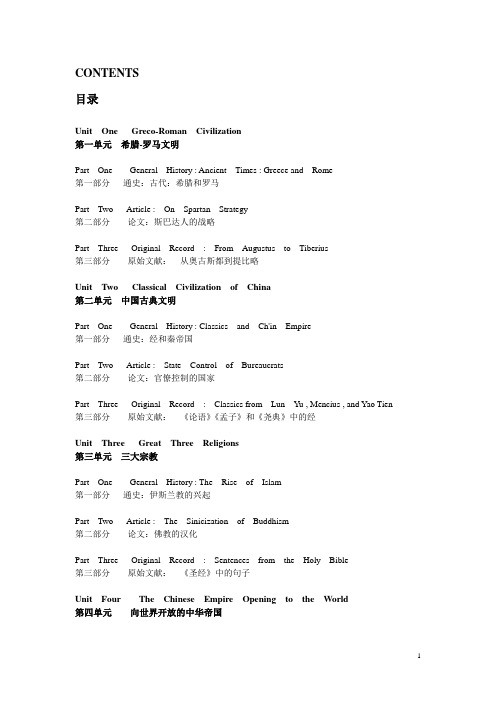
CONTENTS目录Unit One Greco-Roman Civilization第一单元希腊-罗马文明Part One General History : Ancient Times : Greece and Rome第一部分通史:古代:希腊和罗马Part Two Article : On Spartan Strategy第二部分论文:斯巴达人的战略Part Three Original Record : From Augustus to Tiberius第三部分原始文献:从奥古斯都到提比略Unit Two Classical Civilization of China第二单元中国古典文明Part One General History : Classics and Ch'in Empire第一部分通史:经和秦帝国Part Two Article : State Control of Bureaucrats第二部分论文:官僚控制的国家Part Three Original Record : Classics from Lun Y u , Mencius , and Y ao Tien 第三部分原始文献:《论语》《孟子》和《尧典》中的经Unit Three Great Three Religions第三单元三大宗教Part One General History : The Rise of Islam第一部分通史:伊斯兰教的兴起Part Two Article : The Sinicization of Buddhism第二部分论文:佛教的汉化Part Three Original Record : Sentences from the Holy Bible第三部分原始文献:《圣经》中的句子Unit Four The Chinese Empire Opening to the W orld第四单元向世界开放的中华帝国Part One General History : The Growth of Han Empire第一部分通史:汉帝国的发展Part Two Article : Sale of Office in the Later Han第二部分论文:汉后期的官职买卖Part Three Original Record : The Selections from New Discourses第三部分原始文献:《新语》选文Unit Five The Flow ering of Traditional China第五单元传统中国的盛世Part One General History : The Sui ,Tang , and Song Dynasties第一部分通史:隋、唐和宋王朝Part Two Article : Military Families and the Southern Song第二部分论文:军户和南宋Part Three Original Record : The Turpan Documents第三部分原始文献:吐鲁番文献Unit Six Italian Renaissance第六单元意大利文艺复兴Part One General History : Origins & Art第一部分通史:古代:起源和艺术Part Two Article : The Discovery of the Individual in Renaissance第二部分论文:文艺复兴中“人”的发现Part Three Original Record : The Prince第三部分原始文献:《君主论》Unit Seven Absorption of Nomadic Civilization into Agricultural Civilization第七单元游牧文明与农耕文明的融合Part One General History : China in the Mongol Empire第一部分通史:蒙古帝国时代的中国Part Two Article : What Set the Mongols in Motion ?第二部分论文:什么使蒙古人动起来?Part Three Original Record : Kublai Khan's Life in Shangdu第三部分原始文献:忽必烈大汗在上都的生活Unit Eight The Empire Trying to Be " Blue China "第八单元试图成为“蓝色中国”的帝国Part One General History : The Maritime Expedition of Zheng He第一部分通史:郑和的海洋探险Part Two Article : From Rebel Base to Imperial Capital第二部分论文:从反叛基地到帝国都城Part Three Original Record : Stone Record of the Pacification of the Pirates第三部分原始文献:《平寇碑记》Unit Nine Religious Reform第九单元宗教改革Part One General History : Luther and Lutheranism第一部分通史:路德和路德教Part Two Article : The Diversity of Revelation第二部分论文:启示录的差异Part Three Original Record : Institutes of the Christian Religion第三部分原始文献:《基督教原理》Unit T en Iberian Expansion第十单元伊比利亚的扩张Part One General History : Portugal's and Spain's Colonial Conquest第一部分通史:葡萄牙和西班牙的殖民征服Part Two Article : The Theory of Natural Slavery第二部分论文:天生奴隶说Part Three Original Record : The Documents of Iberian Expansion第三部分原始文献:伊比利亚扩张的文献Unit Eleven The Last Dynasty of China's Dynastic Circle第十一单元中国朝代循环的末代王朝Part One General History : The Qing Dynasty Before 1800第一部分通史:1800年以前的清王朝Part Two Article : Social Discrimination in Traditional China第二部分论文:传统中国的社会歧视Part Three Original Record : A Bridge and Its Man第三部分原始文献:一座桥及其观光者Unit Tw elve Three Bourgeois Revolutions第十二单元三大资产阶级革命Part One General History : The English Revolution第一部分通史:英国革命Part Two Article : The Central Themes of the American Revolution第二部分论文:美国革命的核心主题Part Three Original Record : The Documents of French Bourgeois Revolution第三部分原始文献:法国资产阶级革命的文献Unit Thirteen Industrial Revolution第十三单元工业革命Part One General History : The Age of Machines第一部分通史:机器时代Part Two Article : The Industrial Revolution—— an Overview第二部分论文:工业革命——概观Part Three Original Record : Reminiscences of the First Railroad Over the Allegheny Mountain第三部分原始文献:追忆通过阿勒格尼山的第一条铁路(1879)Unit Fourteen The Semi-Colonial and Semi-Feudalist China第十四单元半殖民地半封建社会的中国Part One General History : The Opium War第一部分通史:鸦片战争Part Two Article : The Great Policy Debate in China ,1874: Maritime Defense vs. Frontier Defense第二部分论文:中国1874年政策大讨论:海防对陆防Part Three Original Record : Treaty of Nanjing (Nanking) ,1842第三部分原始文献:《南京条约》,1842Unit Fifteen The Meiji Restoration of Japan第十五单元日本明治维新Part One General History : The Establishment of the New Government The First World War第一部分通史:新政府的成立Part Two Article : The Military第二部分论文:军队Part Three Original Record : Thoughts on the Political Economy第三部分原始文献:政治经济学上的思考Unit Sixteen Tw o W orld W ars第十六单元希腊-罗马文明Part One General History : The First World War第一部分通史:第一次世界大战Part Two Article : Nazi Foreign Policy第二部分论文:纳粹的对外政策Part Three Original Record : The Documents of WW II第三部分原始文献:第二次世界大战的文献Unit Seventeen Russian Revolution of 1917第十七单元俄国1917年革命Part One General History : The Revolution of 1917第一部分通史:1917年革命Part Two Article : The Sources of Soviet Conduct第二部分论文:苏维埃现象的根源Part Three Original Record : The October Revolution第三部分原始文献:十月革命Unit Eighteen The Rise of Modern China第十八单元中国的兴起Part One General History : The Birth of the People's Republic第一部分通史:人民共和国的诞生Part Two Article : To Reform a Revolution : Under the Righteous Mandate 第二部分论文:改良革命:按照正义的指令Part Three Original Record : The War of Resistance Against Japan第三部分原始文献:抗日战争Unit Nineteen The Cold W ar第十九单元冷战Part One General History : The Beginning of the Cold War第一部分通史:冷战的开始Part Two Article : US Foreign Policy and Origins of the Cold War第二部分论文:美国对外政策和冷战的形成Part Three Original Record : The Iron Curtain第三部分原始文献:铁幕演说Unit Tw enty China on the W ay to a Rich Pow er第二十单元走在富强之路上的中国Part One General History : Economic Reform and the Open Door Policy 第一部分通史:经济改革和对外开放政策Part Two Article : The Rise of China第二部分论文:中国的崛起Part Three Original Record : Deng Xiaoping's Speech第三部分原始文献:邓小平的演说。
给排水专业英语蓝梅课文翻译第七单元
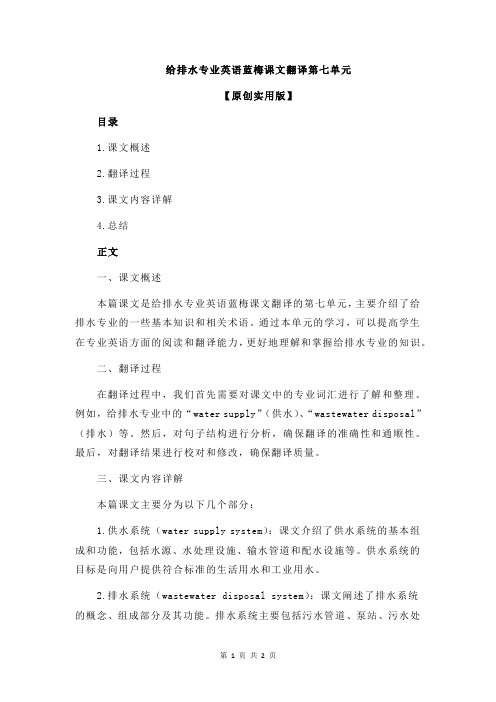
给排水专业英语蓝梅课文翻译第七单元【原创实用版】目录1.课文概述2.翻译过程3.课文内容详解4.总结正文一、课文概述本篇课文是给排水专业英语蓝梅课文翻译的第七单元,主要介绍了给排水专业的一些基本知识和相关术语。
通过本单元的学习,可以提高学生在专业英语方面的阅读和翻译能力,更好地理解和掌握给排水专业的知识。
二、翻译过程在翻译过程中,我们首先需要对课文中的专业词汇进行了解和整理。
例如,给排水专业中的“water supply”(供水)、“wastewater disposal”(排水)等。
然后,对句子结构进行分析,确保翻译的准确性和通顺性。
最后,对翻译结果进行校对和修改,确保翻译质量。
三、课文内容详解本篇课文主要分为以下几个部分:1.供水系统(water supply system):课文介绍了供水系统的基本组成和功能,包括水源、水处理设施、输水管道和配水设施等。
供水系统的目标是向用户提供符合标准的生活用水和工业用水。
2.排水系统(wastewater disposal system):课文阐述了排水系统的概念、组成部分及其功能。
排水系统主要包括污水管道、泵站、污水处理厂和出水口等,其主要任务是将生活、工业和雨水等污水收集、处理和排放,以保护环境和人类健康。
3.给排水工程(water supply and drainage engineering):课文描述了给排水工程的概念、分类和主要任务。
给排水工程包括水源工程、供水工程、排水工程和污水处理工程等,其目标是合理开发和利用水资源,提高水资源的利用效率,保障水资源的可持续利用。
4.给排水专业英语(water supply and drainage professional English):课文介绍了给排水专业英语的重要性和基本要求。
学习给排水专业英语有助于提高学生在国际交流和合作中的沟通能力,促进我国给排水事业的发展。
四、总结通过对本单元课文的翻译和学习,我们不仅提高了专业英语阅读和翻译能力,还加深了对给排水专业知识的理解。
牛津译林版英语七下Unit 7《Abilities》教学设计2

牛津译林版英语七下Unit 7《Abilities》教学设计2一. 教材分析牛津译林版英语七下Unit 7《Abilities》主要讨论了人们在日常生活中所需的各种能力,如学习、工作、娱乐等。
通过本单元的学习,学生能够掌握有关能力的基本词汇和表达方式,学会如何询问和描述一个人的能力。
本单元包括三个课时,主要内容如下:1.单词和短语的学习:如 ability, skill, talent, weak, strong 等。
2.对话练习:学会如何询问和描述一个人的能力。
3.语法点:一般现在时的运用。
二. 学情分析七年级的学生已经掌握了一定的英语基础知识,具备一定的听说读写能力。
但学生在语言运用方面,特别是在口语表达和语法运用上仍有待提高。
此外,学生对自我认知和他人认知的能力有待加强。
三. 教学目标1.知识目标:学生能够掌握本单元的单词、短语和句型,了解一般现在时的运用。
2.能力目标:学生能够用英语询问和描述一个人的能力,提高自我认知和他人认知的能力。
3.情感目标:培养学生热爱学习、自信自强的精神风貌。
四. 教学重难点1.重点:单词、短语和句型的学习与运用。
2.难点:一般现在时的运用和口语表达。
五. 教学方法1.任务型教学法:通过设定各种实际情境,让学生在完成任务的过程中运用英语。
2.情境教学法:创设各种生活情境,激发学生的学习兴趣。
3.合作学习法:鼓励学生分组讨论,提高团队协作能力。
六. 教学准备1.教材:牛津译林版英语七下Unit 7《Abilities》课本、练习册。
2.课件:利用多媒体课件辅助教学。
3.教学资源:图片、视频等。
七. 教学过程1.导入(5分钟)利用图片或视频引入本课主题,激发学生的学习兴趣。
教师简要介绍本课内容,引导学生关注能力的重要性。
2.呈现(10分钟)教师展示本课的生词和短语,引导学生跟读并理解其含义。
通过举例说明,让学生学会如何用英语询问和描述一个人的能力。
3.操练(15分钟)学生分组进行角色扮演,模拟生活中询问和描述能力的场景。
机械设计制造及其自动化专业英语翻译第七单元

ShapersShapers are machine tools used primarily in the production of flat and angular surfaces. In addition,the shaper is used to machine irregular shapes and contours which are difficult to produce on other machine tools. Internal as well as external surfaces and shapes can be produced on the shaper. Common shapes produced on the shaper are flat, angular,grooves, dovetails,T-slots,keyways,slots,serrations, and contours. Single-point cutting tools similar to the type used on the lathe are used in machining most surfaces on the shaper。
Contour surfaces can be produced with either a single—point tool or a formed cutting tool。
When using a single-point cutting tool for contour surfaces, the depth of cut must be constantly regulated by the machine operator to achieve the proper contour . Profiling attachments can be used on some shapers to regulate the feed motion and provide duplication of other parts。
汽车专业英语第七章
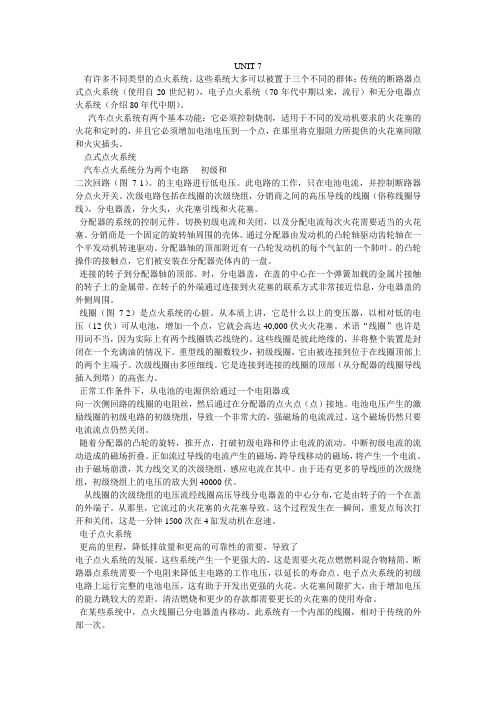
UNIT 7有许多不同类型的点火系统。
这些系统大多可以被置于三个不同的群体:传统的断路器点式点火系统(使用自20世纪初),电子点火系统(70年代中期以来,流行)和无分电器点火系统(介绍80年代中期)。
汽车点火系统有两个基本功能:它必须控制烧制,适用于不同的发动机要求的火花塞的火花和定时的,并且它必须增加电池电压到一个点,在那里将克服阻力所提供的火花塞间隙和火灾插头。
点式点火系统汽车点火系统分为两个电路- 初级和二次回路(图7-1)。
的主电路进行低电压。
此电路的工作,只在电池电流,并控制断路器分点火开关。
次级电路包括在线圈的次级绕组,分销商之间的高压导线的线圈(俗称线圈导线),分电器盖,分火头,火花塞引线和火花塞。
分配器的系统的控制元件。
切换初级电流和关闭,以及分配电流每次火花需要适当的火花塞。
分销商是一个固定的旋转轴周围的壳体。
通过分配器由发动机的凸轮轴驱动齿轮轴在一个半发动机转速驱动。
分配器轴的顶部附近有一凸轮发动机的每个气缸的一个肺叶。
的凸轮操作的接触点,它们被安装在分配器壳体内的一盘。
连接的转子到分配器轴的顶部。
时,分电器盖,在盖的中心在一个弹簧加载的金属片接触的转子上的金属带。
在转子的外端通过连接到火花塞的联系方式非常接近信息,分电器盖的外侧周围。
线圈(图7-2)是点火系统的心脏。
从本质上讲,它是什么以上的变压器,以相对低的电压(12伏)可从电池,增加一个点,它就会高达40,000伏火火花塞。
术语“线圈”也许是用词不当,因为实际上有两个线圈铁芯线绕约。
这些线圈是彼此绝缘的,并将整个装置是封闭在一个充满油的情况下。
重型线的圈数较少,初级线圈,它由被连接到位于在线圈顶部上的两个主端子。
次级线圈由多匝细线。
它是连接到连接的线圈的顶部(从分配器的线圈导线插入到塔)的高张力。
正常工作条件下,从电池的电源供给通过一个电阻器或向一次侧回路的线圈的电阻丝,然后通过在分配器的点火点(点)接地。
电池电压产生的激励线圈的初级电路的初级绕组,导致一个非常大的,强磁场的电流流过。
物流专业英语单词1-8单元
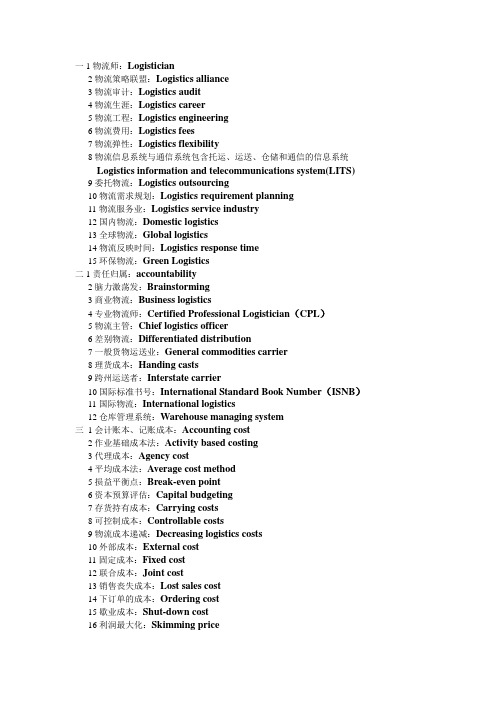
一1物流师:Logistician2物流策略联盟:Logistics alliance3物流审计:Logistics audit4物流生涯:Logistics career5物流工程:Logistics engineering6物流费用:Logistics fees7物流弹性:Logistics flexibility8物流信息系统与通信系统包含托运、运送、仓储和通信的信息系统Logistics information and telecommunications system(LITS) 9委托物流:Logistics outsourcing10物流需求规划:Logistics requirement planning11物流服务业:Logistics service industry12国内物流:Domestic logistics13全球物流:Global logistics14物流反映时间:Logistics response time15环保物流:Green Logistics二1责任归属:accountability2脑力激荡发:Brainstorming3商业物流:Business logistics4专业物流师:Certified Professional Logistician(CPL)5物流主管:Chief logistics officer6差别物流:Differentiated distribution7一般货物运送业:General commodities carrier8理货成本:Handing casts9跨州运送者:Interstate carrier10国际标准书号:International Standard Book Number(ISNB)11国际物流:International logistics12仓库管理系统:Warehouse managing system三1会计账本、记账成本:Accounting cost2作业基础成本法:Activity based costing3代理成本:Agency cost4平均成本法:Average cost method5损益平衡点:Break-even point6资本预算评估:Capital budgeting7存货持有成本:Carrying costs8可控制成本:Controllable costs9物流成本递减:Decreasing logistics costs10外部成本:External cost11固定成本:Fixed cost12联合成本:Joint cost13销售丧失成本:Lost sales cost14下订单的成本:Ordering cost15歇业成本:Shut-down cost16利润最大化:Skimming price17标准成本:Standard cost18开办成本:Start-up costs四1运费优待:Aggregate tender rate2联合包装:Banded pack3顺序托运单:Bill of Lading,order4账单上的货重:Billed weight5空重:Deadweight6倾斜式输送机:Declining conveyor7悬吊式运输:Goods on hanger(GOH)8汽车货运业:Hauler9高速行进中侧重:High speed weight-in-motion(HSWIN)10工业包装:Industrial packaging11轻卡车:Light trucks12长途短途差别取价:Long-haul-short-haul discrimination 13零担运输:LTL shipment14运送方式:Method of shipment15汽车运输业合理运费:Motor carrier reasonable rate16包裹:Package17包裹运送业:Package hauler18套装软件:Package software19托盘:Pallet五1售后服务:After-sales service2延迟订单:Back order3客户态度:Customer attitude4客户导向:Customer driven5自领:Customer pickup6客户关系管理:Customer relation management7客户往来保持:Customer retention8客户满意:Customer satisfaction9定做软件:Customer software10客户周转率:Customer turnover rate11客户价值:Customer value六1订单后组装:Assembly-to-order2自动仓储系统:Automated storage and retrieval system3可用存货:Available inventory4月台:Dock5月台缓冲垫:Dock bumpers6自行组装:Do-it-yourself7高背集装箱:High cube container8高密度负荷:High-density load9存货余额:Inventory balances10存货模式:Inventory modeling11装载率:Load factor12负荷比:Load ratio13装卸费:Loading and unloading fees14托盘式货架:Pallet rack15拣货时间:Picker time16平车载运拖车:Trailer-on-flatcar七1买方拍卖:Buyers auction2集中采购:Centralized procurement3采购经理认证:Certified Purchasing Manager4联合采购:Cooperative buying5经济订购区:Economic order interval6经济订购量:Economic order quantity7购买4个O:Four Os of purchasing8全球采购:Global sourcing9订单履行:Order filling10采购订单:Purchase order11采购前置时间:Purchasing lead time12购货退回或折让:Purchase returns and allowance。
计算机专业英语课后题答案汇总

课后题答案.doc第六章Dbcbbaacbd jachgidefb7Ababdadcdb iefjabgdch8Aacacacddc gajidbhcfe9Cbadcdbbbd gbaihecjdf第10章Aadbacdcbd ghfabcjdei计算机专业英语+单词+部分习题计算机专业英语(2008影印版)高等教育出版社共10页KEY TERMS第一单元application software应用软件basic application基本应用软件communication device通信设备compact disc (CD)光盘computer competency计算机能力Connectivity连通性Data数据database file数据库文件desktop computer台式计算机device driver磁盘驱动程序digital versatile disc(DVD)数字多用途光盘digital video disc(DVD)数字多用途光盘document file文档文件end user终端用户floppy disk软盘handheld computer手持计算机hard disk硬盘Hardware硬件High definition高清Information信息information system信息系统information technology信息技术input device输入设备Internet因特网Keyboard键盘mainframe computer大型机Memory内存Microcomputer微型机Microprocessor微处理器midrange computer中型机Minicomputer小型计算机Modem调制解调器Monitor监视器Mouse鼠标Network网络notebook computer笔记本电脑operating system操作系统optical disk光盘output device输出设备palm computer掌上电脑Peoplepersonal digital assistant(PDA)个人数字助理presentation file演示文稿primary storage主存Printer打印机Procedure规程Program程序random access memory随机存储器secondary storage device辅存Software软件specialized application专门应用软件Supercomputer巨型机system software系统软件system unit系统单元tablet PC平板电脑Utility实用程序wireless revolution无线革命worksheet file工作表第三单元analytical graph分析图application software应用软件Autocontent Wizard内容提示向导basic applications基础应用软件bulleted list项目符号列表business suite商业套装软件Button按键Cell单元格character effect字效Chart图表Column列Computer trainer计算机培训员Contextual tab上下文标签Database数据库database management system (DBMS)数据库管理系统database manager数据库管理员Design template设计模板dialog box对话框Document文件Editing编辑Field字段find and replace查找和替换Font字体font size字号Form窗体Format格式Formula公式Function函数Galleries图库grammar checker语法检查器graphical user interface (GUI)图形用户界面home software家庭软件home suite家庭套装软件Icons图标integrated package集成组件Label标签master slide母板Menu菜单menu bar菜单栏numbered list编号列表numeric entry数值型输入personal software个人软件personal suite个人套装软件Pointer指针presentation graphic图形演示文稿productivity suite生产力套装软件Query查询Range范围Recalculation重算Record记录relational database关系型数据Report报表Ribbons功能区、格式栏Row行Sheet工作表Slide幻灯片software suite软件套装Sort排序specialized applications专用应用程序specialized suite专用套装软件speech recognition语音识别spelling checker拼写检查器spreadsheet电子表格system software系统软件Table表格text entry文本输入Thesaurus[θis?:r?s]分类词汇集Toolbar工具栏user interface用户界面utility suite实用套装软件what-if analysis变化分析Window窗口word processor文字处理软件word wrap字回行workbook file工作簿Worksheet工作表第四单元Animation动画artificial intelligence (AI)人工智能artificial reality虚拟现实audio editing software音频编辑软件bitmap image位图Blog博客Buttons按键clip art剪辑图Desktop publisher桌面发布desktop publishing program桌面印刷系统软件drawing program绘图程序expert systems专家系统Flash动画fuzzy logic模糊逻辑graphical map框图graphics suite集成图HTML editors HTML编辑器illustration program绘图程序Image editors图像编辑器image gallery图库immersive experience沉浸式体验industrial robots工业机器人Interactivity交互性knowledge bases知识库knowledge-based system知识库系统Link链接mobile robot移动式遥控装置Morphing渐变Multimedia多媒体multimedia authoring programs多媒体编辑程序page layout program页面布局程序perception systems robot感知系统机器人Photo editors图像编辑器Pixel[piks?l]像素raster image光栅图像Robot机器人Robotics机器人学stock photographs照片库story boards故事版Vector[vekt?]矢量vector illustration矢量图vector image矢量图象video editing software视频编辑软件virtual environments虚拟环境virtual reality虚拟现实virtual reality modeling language (VRML)虚拟现实建模语言virtual reality wall虚拟现实墙VR虚拟现实Web authoring网络编程Web authoring program网络编辑程序Web log网络日志Web page editor网页编辑器Add Printer Wizard添加打印机向导Antivirus program反病毒程序Backup备份backup program备份程序Booting启动、引导cold boot冷启动computer support specialist计算机支持专家Dashboard widgets仪表盘Desktop桌面desktop operating system桌面操作系统device driver磁盘驱动程序diagnostic program诊断程序dialog box对话框Disk Cleanup磁盘清理Disk Defragmenter磁盘碎片整理器Driver驱动器embedded operating systems嵌入式操作系统File文件file compression program文件压缩程序Folder文件夹Fragmented碎片化graphical user interface (GUI)图形用户界面Help帮助Icon图标language translator语言编译器leopard[lep?d]雪豹操作系统LinuxMac OS Mac操作系统Mac OS XMenu菜单Multitasking多任务处理network operating systems(NOS)网络操作系统network server网络服务器One Button Checkup一键修复operating system操作系统Platform平台Pointer指针Sectors[sekt?]扇区software environment软件环境Spotlight聚光灯stand-alone operating system独立操作系统system software系统软件Tiger老虎操作系统troubleshooting program故障检修程序Uninstall program卸载程序UNIXuser interface用户界面Utility实用程序utility suite实用套装软件Virus[vai?r?s]病毒warm boot热启动Window视窗Windows视窗操作系统Windows Update Windows更新Windows VistaWindows XP第六单元AC adapter 交流适配器Accelerated graphics port(AGP):图形加速端口Arithmetic-logic unit(ALU):算术逻辑单元Arithmetic operation:算术运算ASCII美国标准信息交换码Binary coding schemes:二进制编码制Bit:位Bus:总线Bus line:总线Byte:字节Cable:电缆Cache memory:高速缓存carrier package 封装物Central processing unit (CPU):中央处理器Chip:芯片Clock speed时钟速度Complementary metal-oxide semiconductor:互补金属氧化物半导体Computer technician计算机工程师Control unit:控制单元Coprocessor协处理器Desktop system unit:桌面系统单元Digital数字的Dual-core chips双核芯片EBCDIC:扩展二进制编码的十进制交换码Expansion bus扩展总线Expansion card扩展卡Expansion slot扩展槽FireWire port:火线接口Flash memory闪存Graphics card图形适配卡Graphics coprocessor图形协处理器Handheld computer system unit 手持计算机系统单元Industry standard architecture(ISA)工业标准结构Infrared Data Association(IrDA)红外线传输模组Integrated circuit:集成电路Laptop computer膝式计算机Logical operation逻辑运算Microprocessor:微处理器Motherboard:主板Musical instrument digital interface(MIDI)乐器数字接口Network adapter card网络适配卡Network interface card(NIC)网络接口卡Notebook system unit:笔记本Parallel ports:并行端口Parallel processing并行处理Pc card: :个人计算机插卡PCI Express(PCIe)Peripheral component interconnect (PCI):外围部件互联Personal digital assistant (PDA) 个人数字助理Plug and play:即插即用Port:端口Power supply unit 供电设备Processor:处理器RAM cache: RAM高速缓存Random-access memory (RAM):随机存储器Read-only memory (ROM):只读存储器RFID tag射频识别标签Semiconductor:半导体serial ATA(SATA)串行A TA接口规范Serial ports:串行端口Silicon chip:硅芯片Slot:插槽Smart card:智能卡sound card声卡System board:系统板System cabinet:主机System clock:系统时钟System unit:系统单元tablet PC平板式电脑tablet PC system unit平板式电脑系统单元TV tuner card:电视调频卡Unicode:统一字符编码标准Universal serial bus (USB):通用串行总线Universal serial bus (USB) port:通用串行总线端口Virtual memory:虚拟存储器Word:字第七单元active-matrix monitor有源矩阵显示器bar code条形码bar code reader条形码阅读器cathode ray tube monitor (CRT)阴极射线管显示器Clarity清晰度combination key组合键cordless mouse无线鼠标data projector数据投影仪digital camera数码照相机Digital media player数字媒体播放器Digital music player数码音乐播放器digital video camera数码影像摄录机dot pitch点距dot-matrix printer针式打印机dots-per-inch (dpi)点每英寸dual-scan monitor双向扫描显示器dumb terminal哑终端e-book电子图书阅读器ergonomic keyboard人体工程学键盘Fax machine传真机flat-panel monitor平面显示器Flatbed scanner平板扫描仪flexible keyboard可变形键盘handwriting recognition software手写识别软件Headphones耳机high-definition television (HDTV)高清电视ink-jet printer喷墨打印机intelligent terminal智能终端Internet telephone网络电话Internet telephony网络电话IP Telephony IP电话Joystick游戏杆Keyboard键盘laser printer激光打印机light pen光笔Liquid crystal display(LCD)液晶显示器Magnetic card reader磁卡阅读器magnetic-ink character recognition (MICR)磁性墨水字符识别mechanical mouse机械鼠标Monitor显示器Mouse鼠标mouse pointer鼠标指针multifunction device (MFD)多功能设备network terminal网络终端numeric keypad数字小键盘optical-character recognition (OCR)光学字符识别optical-mark recognition (OMR)光学标记识别optical mouse光电鼠标Optical scanner光电扫描仪passive-matrix monitor无源矩阵显示器PDA keyboard PDA键盘personal laser printer个人激光打印机photo printer照片打印机picture elements 有效像素Pixel像素Pixel pitch像素间距platform scanner平版式扫描仪Plotter绘图仪pointing stick触控点portable printer便携式打印机portable scanner便携式扫描仪Printer打印机Radio frequency card reader射频卡阅读器Radio frequency identification(RFID)射频识别refresh rate刷新率Resolution分辨率roller ball滚动球shared laser printer共享激光打印机Speakers扬声器Stylus[stail?s]输入笔Technical writer技术文档编写员telephony[tilef?ni]电话Terminal终端thermal printer[θ?:m?l]热敏打印机thin client瘦客户端thin film transistor monitor (TFT)薄膜晶体管显示器toggle key[t?ɡl]切换键touch pad触控板touch screen触摸屏Trackball轨迹球traditional keyboard传统键盘Universal Product Code (UPC)同一产品编码voice-over IP (VoIP)网络电话voice recognition system语音识别系统wand reader棒式阅读器WebCam摄像头wheel button滚动键wireless keyboard无线键盘wireless mouse无线鼠标第八单元access speed存取速度Blu-Ray(BD)蓝光Capacity容量CD (compact disc)光盘CD-R (CD-recordable)可录式CDCD-ROM (compact disc-read only memory)光盘库CD-RW (compact disc rewritable)可重写CDCylinder[silind?]柱面Density密度direct access直接存取disk caching磁盘缓存DVD(digital versatile disc or digital video disc)DVD player DVD播放器DVD- R (DVD recordable)可录式DVDDVD +R (DVD recordable)可录式DVDDVD-RAM(DVD random-access memory)DVD随机存取器DVD-ROM(DVD random-read-only memory)DVD只读存储器DVD-ROM jukeboxDVD-RW (DVD rewritable)可重写DVDEnterprise storage system企业存储系统erasable optical disk可擦光盘file compression文件压缩file decompression文件解压缩File server文件服务器flash memory card闪存卡floppy disk软盘Floppy disk cartridge软盘盒floppy disk drive (FDD)软磁盘驱动器hard disk硬盘hard-disk cartridge硬盘盒hard-disk pack硬盘组HD DVD(high-definition DVD)高清DVDhead crash磁头碰撞Hi def(high definition)高清high capacity disk高容量磁盘internal hard disk内置硬盘Internet hard drive网络硬盘驱动器Label标签Land平地magnetic tape磁带magnetic tape reel磁带盒magnetic tape streamer磁带条Media多媒体optical disk光盘optical disk drive光盘驱动器Organizational Internet storage组织性网络存储PC Card hard disk PC卡硬盘Pit坑primary storage主存RAID system磁碟阵列系统Redundant array of inexpensive disks(RAID)廉价磁盘冗余阵列secondary storage辅存Sector扇区sequential access顺序存取Shutter滑盖Software engineer软件工程师solid-state storage固态存储器storage devices存储装置tape cartridge盒式带Track轨道USB drive USB驱动器write-protection notch写入保护缺口第九单元3G cellular networkanalog signal 模拟信号asymmetric digital subscriber line(ADSL)非对称数字用户线路Backbone中枢Bandwidth带宽base station基址bits per second位/秒Bluetooth 蓝牙Broadband宽带broadcast radio无线广播Bus总线bus network总线网络cable modem电缆调制解调器cellular service无线服务Client 客户client/server network system客户/服务网络系统coaxial cable同轴电缆communication channel 信道communication system 通信系统computer network计算机网络Connectivity连通性Demodulation 解调dial-up service拨号服务digital signal数字信号digital subscriber line (DSL)数字用户线路distributed data processing分布式数据处理系统distributed processing分布处理domain name server (DNS)域名服务Ethernet以太网external modem外置调制解调器Extranet外联网fiber-optic cable 光纤电缆Firewall防火墙global positioning system (GPS)全球卫星定位系统hierarchical network树型网络home network家庭网络host computer主机Hub集线器Infrared红外线internal modem 内置式调制解调器Intranet内联网IP address (Internet Protocol address)IP地址local area network (LAN)局域网low bandwidth低频带宽medium band 中频波段metropolitan area network (MAN) 城域网Microwave微波Modem调制解调器Modulation调制network administrator网络管理员network architecture网络体系结构network gateway 网关network hub 网络集线器network interface card (NIC)网络接口卡network operating system (NOS)网络操作系统Node 节点Packet 数据包PC card modem PC卡调制解调器peer-to-peer network system 对等网络系统Polling 轮流检测Protocol协议proxy server代理服务器ring network环型网络Satellite卫星satellite/air connection service卫星互连服务Server服务器star network 星型网络Strategy策略T1, T2, T3, T4 linestelephone line电话线terminal network 终端网络time-sharing system并发式系统Topology拓扑结构transfer rate传输率TCP/IP (transmission control protocol/Internet protocol)传输控制协议/因特网协议voiceband声音带宽wide area network (W AN)广域网Wi-FI (wireless fidelity)无限保真wireless LAN (WLAN)无线局域网wireless modem无线调制解调器wireless receiver无线接收器课后习题答案:Ch1: Ch6:bbabd,dacdd; eichafgbdj. dbcbb,aacbd; jachgidefb.Ch3: Ch7:dcbdd,abccb; jachbdiegf. Ababd,adcdb; iefjabgdch.Ch4: Ch8:aaaba,bcbab; igdecfhbja. dacac,acddc; gajidbhcfe.Ch5: Ch9:cdcaa,cbbac; gdfbghaeic. abadc,dbbbd; gbaidecjhf.中英文对照的ERP专业词汇介绍:B2C、B2B、ASP、APS、BOM、C/S、CAD、CAM、CPC、EDI、GUI、ISO、MIS、PM、SCM、SQL、TQM、line item、planned capacity、rated capacity、virtual warehouse……1 ABM Activity-based Management 基于作业活动管理2 AO Application Outsourcing 应用程序外包3 APICS American Production and Inventory Control Society,Inc 美国生产与库存管理协会4 APICS Applied Manufacturing Education Series 实用制造管理系列培训教材5 APO Advanced Planning and Optimization 先进计划及优化技术6 APS Advanced Planning and Scheduling 高级计划与排程技术7 ASP Application Service/Software Provider 应用服务/软件供应商8 ATO Assemble To Order 定货组装9 ATP Available To Promise 可供销售量(可签约量)10 B2B Business to Business 企业对企业(电子商务)11 B2C Business to Consumer 企业对消费者(电子商务)12 B2G Business to Government 企业对政府(电子商务)13 B2R Business to Retailer 企业对经销商(电子商务)14 BIS Business Intelligence System 商业智能系统15 BOM Bill Of Materials 物料清单16 BOR Bill Of Resource 资源清单17 BPR Business Process Reengineering 业务/企业流程重组18 BPM Business Process Management 业务/企业流程管理19 BPS Business Process Standard 业务/企业流程标准20 C/S Client/Server(C/S)\Browser/Server(B/S) 客户机/服务器\浏览器/服务器21 CAD Computer-Aided Design 计算机辅助设计22 CAID Computer-Aided Industrial Design 计算机辅助工艺设计23 CAM Computer-Aided Manufacturing 计算机辅助制造24 CAPP Computer-Aided Process Planning 计算机辅助工艺设计25 CASE Computer-Aided Software Engineering 计算机辅助软件工程26 CC Collaborative Commerce 协同商务27 CIMS Computer Integrated Manufacturing System 计算机集成制造系统28 CMM Capability Maturity Model 能力成熟度模型29 COMMS Customer Oriented Manufacturing Management System 面向客户制造管理系统30 CORBA Common Object Request Broker Architecture 通用对象请求代理结构31 CPC Collaborative Product Commerce 协同产品商务32 CPIM Certified Production and Inventory Management 生产与库存管理认证资格33 CPM Critical Path Method 关键线路法34 CRM Customer Relationship Management 客户关系管理35 CRP capacity requirements planning 能力需求计划36 CTI Computer Telephony Integration 电脑电话集成(呼叫中心)37 CTP Capable to Promise 可承诺的能力38 DCOM Distributed Component Object Model 分布式组件对象模型39 DCS Distributed Control System 分布式控制系统40 DMRP Distributed MRP 分布式MRP41 DRP Distribution Resource Planning 分销资源计划42 DSS Decision Support System 决策支持系统43 DTF Demand Time Fence 需求时界44 DTP Delivery to Promise 可承诺的交货时间45 EAI Enterprise Application Integration 企业应用集成46 EAM Enterprise Assets Management 企业资源管理47 ECM Enterprise Commerce Management 企业商务管理48 ECO Engineering Change Order 工程变更订单49 EDI Electronic Data Interchange 电子数据交换50 EDP Electronic Data Processing 电子数据处理51 EEA Extended Enterprise Applications 扩展企业应用系统52 EIP Enterprise Information Portal 企业信息门户53 EIS Executive Information System 高层领导信息系统54 EOI Economic Order Interval 经济定货周期55 EOQ Economic Order Quantity 经济订货批量(经济批量法)56 EPA Enterprise Proficiency Analysis 企业绩效分析57 ERP Enterprise Resource Planning 企业资源计划58 ERM Enterprise Resource Management 企业资源管理59 ETO Engineer To Order 专项设计,按订单设计60 FAS Final Assembly Schedule 最终装配计划61 FCS Finite Capacity Scheduling 有限能力计划62 FMS Flexible Manufacturing System 柔性制造系统63 FOQ Fixed Order Quantity 固定定货批量法64 GL General Ledger 总账65 GUI Graphical User Interface 图形用户界面66 HRM Human Resource Management 人力资源管理67 HRP Human Resource Planning 人力资源计划68 IE Industry Engineering/Internet Exploration 工业工程/浏览器69 ISO International Standard Organization 国际标准化组织70 ISP Internet Service Provider 互联网服务提供商71 ISPE International Society for Productivity Enhancement 国际生产力促进会72 IT/GT Information/Group Technology 信息/成组技术73 JIT Just In Time 准时制造/准时制生产74 KPA Key Process Areas 关键过程域75 KPI Key Performance Indicators 关键业绩指标76 LP Lean Production 精益生产77 MES Manufacturing Executive System 制造执行系统78 MIS Management Information System 管理信息系统79 MPS Master Production Schedule 主生产计划80 MRP Material Requirements Planning 物料需求计划81 MRPII Manufacturing Resource Planning 制造资源计划82 MTO Make To Order 定货(订货)生产83 MTS Make To Stock 现货(备货)生产84 OA Office Automation 办公自动化85 OEM Original Equipment Manufacturing 原始设备制造商86 OPT Optimized Production Technology 最优生产技术87 OPT Optimized Production Timetable 最优生产时刻表88 PADIS Production And Decision Information System 生产和决策管理信息系统89 PDM Product Data Management 产品数据管理90 PERT Program Evaluation Research Technology 计划评审技术91 PLM Production Lifecycle Management 产品生命周期管理92 PM Project Management 项目管理93 POQ Period Order Quantity 周期定量法94 PRM Partner Relationship Management 合作伙伴关系管理95 PTF Planned Time Fence 计划时界96 PTX Private Trade Exchange 自用交易网站97 RCCP Rough-Cut Capacity Planning 粗能力计划98 RDBM Relational Data Base Management 关系数据库管理99 RPM Rapid Prototype Manufacturing 快速原形制造100 RRP Resource Requirements Planning 资源需求计划101 SCM Supply Chain Management 供应链管理102 SCP Supply Chain Partnership 供应链合作伙伴关系103 SFA Sales Force Automation 销售自动化104 SMED Single-Minute Exchange Of Dies 快速换模法105 SOP Sales And Operation Planning 销售与运作规划106 SQL Structure Query Language 结构化查询语言107 TCO Total Cost Ownership 总体运营成本108 TEI Total Enterprise Integration 全面企业集成109 TOC Theory Of Constraints/Constraints managemant 约束理论/约束管理110 TPM Total Productive Maintenance 全员生产力维护111 TQC Total Quality Control 全面质量控制112 TQM Total Quality Management 全面质量管理113 WBS Work Breakdown System 工作分解系统114 XML eXtensible Markup Language 可扩展标记语言115 ABC Classification(Activity Based Classification) ABC分类法116 ABC costing 作业成本法117 ABC inventory control ABC 库存控制118 abnormal demand 反常需求119 acquisition cost ,ordering cost 定货费120 action message 行为/活动(措施)信息121 action report flag 活动报告标志122 activity cost pool 作业成本集123 activity-based costing(ABC) 作业基准成本法/业务成本法124 actual capacity 实际能力125 adjust on hand 调整现有库存量126 advanced manufacturing technology 先进制造技术127 advanced pricing 高级定价系统128 AM Agile Manufacturing 敏捷制造129 alternative routing 替代工序(工艺路线)130 Anticipated Delay Report 拖期预报131 anticipation inventory 预期储备132 apportionment code 分摊码133 assembly parts list 装配零件表134 automated storage/retrieval system 自动仓储/检索系统135 Automatic Rescheduling 计划自动重排136 available inventory 可达到库存137 available material 可用物料138 available stock 达到库存139 available work 可利用工时140 average inventory 平均库存141 back order 欠交(脱期)订单142 back scheduling 倒排(序)计划/倒序排产?143 base currency 本位币144 batch number 批号145 batch process 批流程146 batch production 批量生产147 benchmarking 标杆瞄准(管理)148 bill of labor 工时清单149 bill of lading 提货单150 branch warehouse 分库151 bucketless system 无时段系统152 business framework 业务框架153 business plan 经营规划154 capacity level 能力利用水平155 capacity load 能力负荷156 capacity management 能力管理157 carrying cost 保管费158 carrying cost rate 保管费率159 cellular manufacturing 单元式制造160 change route 修改工序161 change structure 修改产品结构162 check point 检查点163 closed loop MRP 闭环MRP164 Common Route Code(ID) 通用工序标识165 component-based development 组件(构件)开发技术166 concurrent engineering 并行(同步)工程167 conference room pilot 会议室模拟168 configuration code 配置代码169 continuous improvement 进取不懈170 continuous process 连续流程171 cost driver 作业成本发生因素172 cost driver rate 作业成本发生因素单位费用173 cost of stockout 短缺损失174 cost roll-up 成本滚动计算法175 crew size 班组规模176 critical part 急需零件177 critical ratio 紧迫系数178 critical work center 关键工作中心179 CLT Cumulative Lead Time 累计提前期180 current run hour 现有运转工时181 current run quantity 现有运转数量182 customer care 客户关怀183 customer deliver lead time 客户交货提前期184 customer loyalty 客户忠诚度185 customer order number 客户订单号186 customer satisfaction 客户满意度187 customer status 客户状况188 cycle counting 周期盘点189 DM Data Mining 数据挖掘190 Data Warehouse 数据仓库191 days offset 偏置天数192 dead load 空负荷193 demand cycle 需求周期194 demand forecasting 需求预测195 demand management 需求管理196 Deming circle 戴明环197 demonstrated capacity 实际能力198 discrete manufacturing 离散型生产199 dispatch to 调度200 DRP Distribution Requirements Planning 分销需求计划201 drop shipment 直运202 dunning letter 催款信203 ECO workbench ECO工作台204 employee enrolled 在册员工205 employee tax id 员工税号206 end item 最终产品207 engineering change mode flag 工程变更方式标志208 engineering change notice 工程变更通知209 equipment distribution 设备分配210 equipment management 设备管理211 exception control 例外控制212 excess material analysis 呆滞物料分析213 expedite code 急送代码214 external integration 外部集成215 fabrication order 加工订单216 factory order 工厂订单217 fast path method 快速路径法218 fill backorder 补足欠交219 final assembly lead time 总装提前期220 final goods 成品221 finite forward scheduling 有限顺排计划222 finite loading 有限排负荷223 firm planned order 确认的计划订单224 firm planned time fence 确认计划需求时界225 FPR Fixed Period Requirements 定期用量法226 fixed quantity 固定数量法227 fixed time 固定时间法228 floor stock 作业现场库存229 flow shop 流水车间230 focus forecasting 调焦预测231 forward scheduling 顺排计划232 freeze code 冻结码233 freeze space 冷冻区234 frozen order 冻结订单235 gross requirements 毛需求236 hedge inventory 囤积库存237 in process inventory 在制品库存238 in stock 在库239 incrementing 增值240 indirect cost 间接成本241 indirect labor 间接人工242 infinite loading 无限排负荷243 input/output control 投入/产出控制244 inspection ID 检验标识245 integrity 完整性246 inter companies 公司内部间247 interplant demands 厂际需求量248 inventory carry rate 库存周转率249 inventory cycle time 库存周期250 inventory issue 库存发放251 inventory location type 仓库库位类型252 inventory scrap 库存报废量253 inventory transfers 库存转移254 inventory turns/turnover 库存(资金)周转次数255 invoice address 发票地址256 invoice amount gross 发票金额257 invoice schedule 发票清单258 issue cycle 发放周期259 issue order 发送订单260 issue parts 发放零件261 issue policy 发放策略262 item availability 项目可供量263 item description 项目说明264 item number 项目编号265 item record 项目记录266 item remark 项目备注267 item status 项目状态268 job shop 加工车间269 job step 作业步骤270 kit item 配套件项目271 labor hour 人工工时272 late days 延迟天数273 lead time 提前期274 lead time level 提前期水平275 lead time offset days 提前期偏置(补偿)天数276 least slack per operation 最小单个工序平均时差277 line item 单项产品278 live pilot 应用模拟279 load leveling 负荷量280 load report 负荷报告281 location code 仓位代码282 location remarks 仓位备注283 location status 仓位状况284 lot for lot 按需定货(因需定量法/缺补法)285 lot ID 批量标识286 lot number 批量编号287 lot number traceability 批号跟踪288 lot size 批量289 lot size inventory 批量库存290 lot sizing 批量规划291 low level code 低层(位)码292 machine capacity 机器能力293 machine hours 机时294 machine loading 机器加载295 maintenance ,repair,and operating supplies 维护修理操作物料296 make or buy decision 外购或自制决策297 management by exception 例外管理法298 manufacturing cycle time 制造周期时间299 manufacturing lead time 制造提前期300 manufacturing standards 制造标准301 master scheduler 主生产计划员302 material 物料303 material available 物料可用量304 material cost 物料成本305 material issues and receipts 物料发放和接收306 material management 物料管理307 material manager 物料经理308 material master,item master 物料主文件309 material review board 物料核定机构310 measure of velocity 生产速率水平311 memory-based processing speed 基于存储的处理速度312 minimum balance 最小库存余量313 Modern Materials Handling 现代物料搬运314 month to date 月累计315 move time , transit time 传递时间316 MSP book flag MPS登录标志317 multi-currency 多币制318 multi-facility 多场所319 multi-level 多级320 multi-plant management 多工厂管理321 multiple location 多重仓位322 net change 净改变法323 net change MRP 净改变式MRP324 net requirements 净需求325 new location 新仓位326 new parent 新组件327 new warehouse 新仓库328 next code 后续编码329 next number 后续编号330 No action report 不活动报告331 non-nettable 不可动用量332 on demand 急需的333 on-hand balance 现有库存量334 on hold 挂起335 on time 准时336 open amount 未清金额337 open order 未结订单/开放订单338 order activity rules 订单活动规则339 order address 订单地址340 order entry 订单输入341 order point 定货点342 order point system 定货点法343 order policy 定货策略344 order promising 定货承诺345 order remarks 定货备注346 ordered by 定货者347 overflow location 超量库位348 overhead apportionment/allocation 间接费分配349 overhead rate,burden factor,absorption rate 间接费率350 owner's equity 所有者权益351 parent item 母件352 part bills 零件清单353 part lot 零件批次354 part number 零件编号355 people involvement 全员参治356 performance measurement 业绩评价357 physical inventory 实际库存358 picking 领料/提货359 planned capacity 计划能力360 planned order 计划订单361 planned order receipts 计划产出量362 planned order releases 计划投入量363 planning horizon 计划期/计划展望期364 point of use 使用点365 Policy and procedure 工作准则与工作规程366 price adjustments 价格调整367 price invoice 发票价格368 price level 物价水平369 price purchase order 采购订单价格370 priority planning 优先计划371 processing manufacturing 流程制造372 product control 产品控制373 product family 产品系列374 product mix 产品搭配组合375 production activity control 生产作业控制376 production cycle 生产周期377 production line 产品线378 production rate 产品率379 production tree 产品结构树380 PAB Projected Available Balance 预计可用库存(量) 381 purchase order tracking 采购订单跟踪382 quantity allocation 已分配量383 quantity at location 仓位数量384 quantity backorder 欠交数量385 quantity completion 完成数量386 quantity demand 需求量387 quantity gross 毛需求量388 quantity in 进货数量389 quantity on hand 现有数量390 quantity scrapped 废品数量391 quantity shipped 发货数量392 queue time 排队时间393 rated capacity 额定能力394 receipt document 收款单据395 reference number 参考号396 regenerated MRP 重生成式MRP397 released order 下达订单398 reorder point 再订购点399 repetitive manufacturing 重复式生产(制造)400 replacement parts 替换零件401 required capacity 需求能力402 requisition orders 请购单403 rescheduling assumption 重排假设404 resupply order 补库单405 rework bill 返工单406 roll up 上滚407 rough cut resource planning 粗资源计划408 rounding amount 舍入金额409 run time 加工(运行)时间410 safety lead time 安全提前期411 safety stock 安全库存412 safety time 保险期413 sales order 销售订单414 scheduled receipts 计划接收量(预计入库量/预期到货量) 415 seasonal stock 季节储备416 send part 发送零件417 service and support 服务和支持418 service parts 维修件419 set up time 准备时间420 ship address 发运地址421 ship contact 发运单联系人422 ship order 发货单423 shop calendar 工厂日历(车间日历)424 shop floor control 车间作业管理(控制)425 shop order , work order 车间订单426 shrink factor 损耗因子(系数)427 single level where used 单层物料反查表428 standard cost system 标准成本体系429 standard hours 标准工时430 standard product cost 标准产品成本431 standard set up hour 标准机器设置工时432 standard unit run hour 标准单位运转工时433 standard wage rate 标准工资率434 status code 状态代码435 stores control 库存控制436 suggested work order 建议工作单437 supply chain 供应链438 synchronous manufacturing 同步制造/同期生产439 time bucket 时段(时间段)。
- 1、下载文档前请自行甄别文档内容的完整性,平台不提供额外的编辑、内容补充、找答案等附加服务。
- 2、"仅部分预览"的文档,不可在线预览部分如存在完整性等问题,可反馈申请退款(可完整预览的文档不适用该条件!)。
- 3、如文档侵犯您的权益,请联系客服反馈,我们会尽快为您处理(人工客服工作时间:9:00-18:30)。
1. What is GPS?GPS, which stands for Global Positioning System, is the only system today able to show your exact position on the Earth anytime, in any weather, anywhere cii. GPS satellite, 24 in all, orbit 11,000 nautical miles above the Earth. They are continuously monitored by ground stations located worldwide. The satellites transmit signals that can be detected by anyone with a GPS receiver. Using the receiver, you can determine your location with great precision.2. What is navigation?Since prehistoric times, people have been trying to figure out a reliable way to tell where they are and to help guide them to where they are going. Cavemen probably used stones and twigs to mark a trail when they set out hunting for food. The earliest mariners followed the coast closely to keep from getting lost. When navigators first sailed into the open ocean, they discovered they could chart their course by following the stars. The ancient Phoenicians used the North Star to journey from Egypt and Crete. According to Homer, the goddess Athena told Odysseus to "keep the Great Bear on his left" during his travels from Calypso's Island. Unfortunately, the stars are only visible at night and only on clear nights.The next major developments in the quest for the perfect method of navigation were the magnetic compass and the sextant. The needle of a compass always points north, so it is always possible to know in what direction you are going. The sextant uses adjustable mirrors to measure the exact angle of the stars, moon, and sun above the horizon. However, in the early days of its use, it was only possible to determine latitude (the location on the Earth measured north or southfrom the equator) from the sextant observations. Sailors were still unable to determine their longitude (the location on the Earth measured east or west) . This was such a serious problem thatin the 17th century, the British formed a special Board of Longitude consisting of well-known scientists. This group offered 20,000 ponds, equal to about a million of today's dollars, to anybody who could find a way to determine a ship's longitude within 30 nautical miles. The generous offer paid off. In 1761, a cabinetmaker named John Harrison developed a shipboard timepiece called a chronometer, which lost or gained only about one second a day-incredibly accurate for the time. For the next two centuries, sextants and chronometers were used in combination to provide latitude and longitude information. In the early 20th century several radio-based navigation systems were developed, which were used widely during World War II. Both allied and enemy ships and airplanes used ground-based radio-navigation systems as the Technology advanced.A few ground-based radio-navigation systems are still in use today. One drawback of using radio waves generated on the ground is that you must. choose between a system that is very accurate but doesn't cover a wide area, or one that covers a wide area but is not very accurate. High-frequency radio waves (like UHF TV) can provide accurate position location but can only be picked up in a small, localized area. Lower frequency radio waves (like AM radio) can cover a large area, but are not a good yardstick to tell you exactly where you are.Scientists, therefore, decided that the only way to provide coverage for the entire world wasto place high-frequency radio transmitters in space. A transmitter high above the Earth sending a high-frequency radio wave with a special coded signal can cover a large area and still overcomemuch of the "noise" encountered on the way to the ground. This is one of the main principles behind the GPS system.3. GPS elementsGPS has 3 parts: the space segment, the user segment, and the control segment. The spacesegment consists of 24 satellites, each in its own orbit ] l,000 nautical miles above the Earth. The user segment consists of receivers, which you can hold in your hand or mount in your car. The control segment consists of ground stations (five of them, located around the world) that makes sure the satellites are working properly.One trip around the Earth in space equals one orbit. The GPS satellites each take 12 hours toorbit the Earth, Each satellite is equipped with an accurate clock to let it broadcast signals coupled with a precise time message. The ground unit receives the satellite signal, which travels at the speed of light. Even at this speed, the signal takes a measurable amount of time to reach thereceiver.The difference between the time the signal is sent and the time it is received, multiplied bythe speed of light, enables the receiver to calculate the distance to the satellite. To measure precise latitude, longitude, and altitude, the receiver measures the time it took for the signals from four separate satellites to get to the receiver.The GPS system can tell your location anywhere on or above the Earth to within about 300feet. Even great accuracy, usually within less than three feet, can 'oe obtained with corrections calculated by a GPS receiver at a known fixed location.4. Satellites in spaceAs we've said, the complete GPS space system includes 24 satellites, 11,000 nautical miles above the Earth, which take 12 hours to go around the Earth once (one orbit). They are positionedso that we can receive signals from six of them nearly 100 percent of the time at any point on Earth. You need that many signals to get the best position information.Satellites are equipped with very precise clocks that-keep accurate time to within three nanoseconds-that's 0.000,000,003, or three billionths, of a second. This precision timing is important because the receiver must know exactly how long it takes for its signal to get to each satellite and return. By knowing the exact amount of time the signal has taken to get back from each satellite, it can calculate its positionc5l.The first GPS satellite was launched in 1978. The first 10 satellites were developmental satellites, called Block I . From 1989 t0 1993, 23 production satellites, called Block Ⅱ, were launched. The launch of the 24th satellite in 1994 completed the system.5. Ground control stationsThe GPS control, or ground, segment consists of unmanned monitor stations located around the world (Hawaii and Kwajalein in the Pacific Ocean, Diego Garcia in the Indian Ocean, Ascension Island in the Atlantic Ocean, and Colorado Springs, Colorado), a master groundstation at Falcon Air Force Base in Colorado Springs, Colorado, and four large ground antenna stations that broadcast signals to the satellites.The stations also track and monitor the GPS satellites.6. ReceiversGPS receivers can be hand carried or installed on aircraft, ships, tanks, submarines, cars, and trucks. These receivers detect, decode, and process GPS satellite signals. More than 100 different receiver models are already in use. The typical handheld receiver is about the size of a cellular telephone, and the newer models are even smaller.7. How GPS worksSo you can more easily understand some of the scientific principles that make GPS work, let's discuss the basic features of the system. The principle behind GPS is the measurement of distance (or "range" ) between the receiver and the satellites. The satellites also tell us exactly where they are in their orbits. It woks something like this: It we know our exact distance from a satellite in space, we know that we are somewhere on the surface of an imaginary sphere with radius equal to the distance to the satellite radius, If we know our exact distance from two satellites, we know that we are located somewhere on the line where the two sphe.res intersect. And, if we take a third measurement, there are only two possible points where we could be located. One of these is usually impossible, and the GPS receivers have mathematical methods of。
